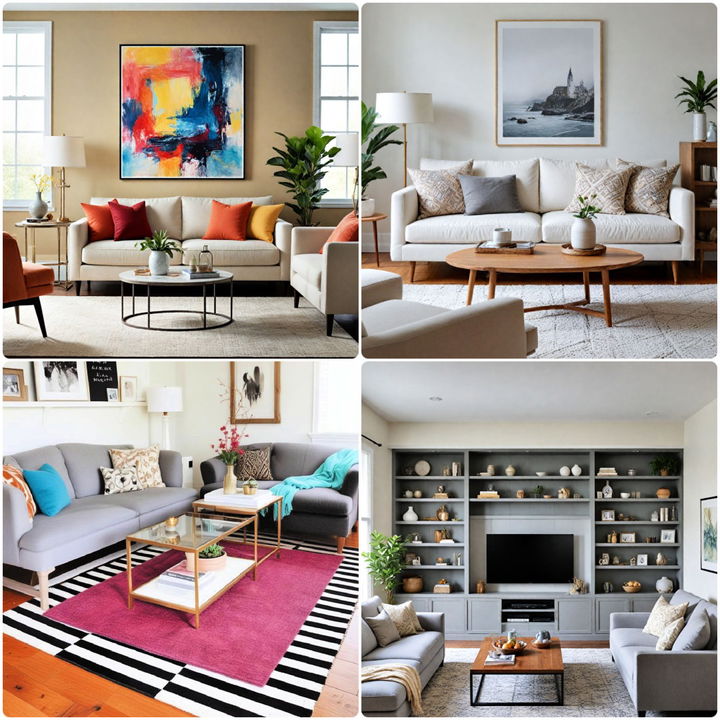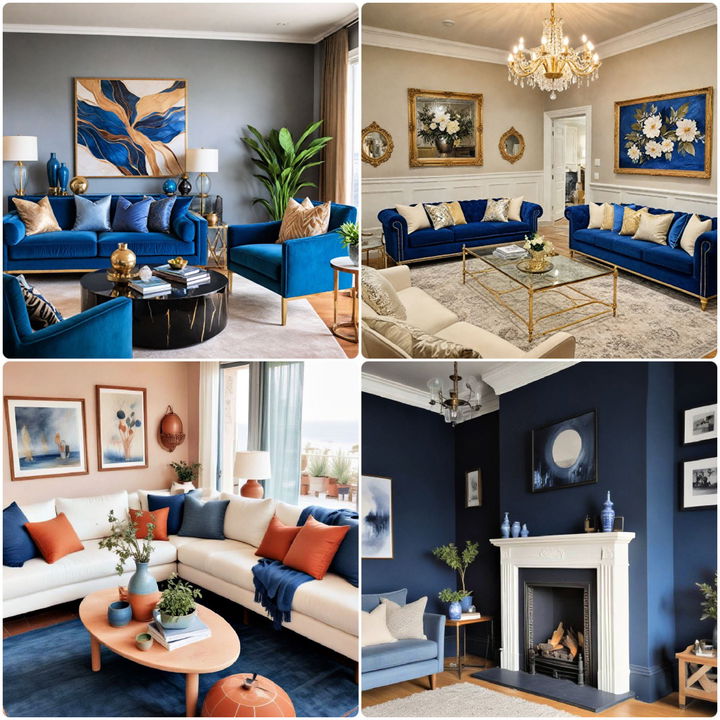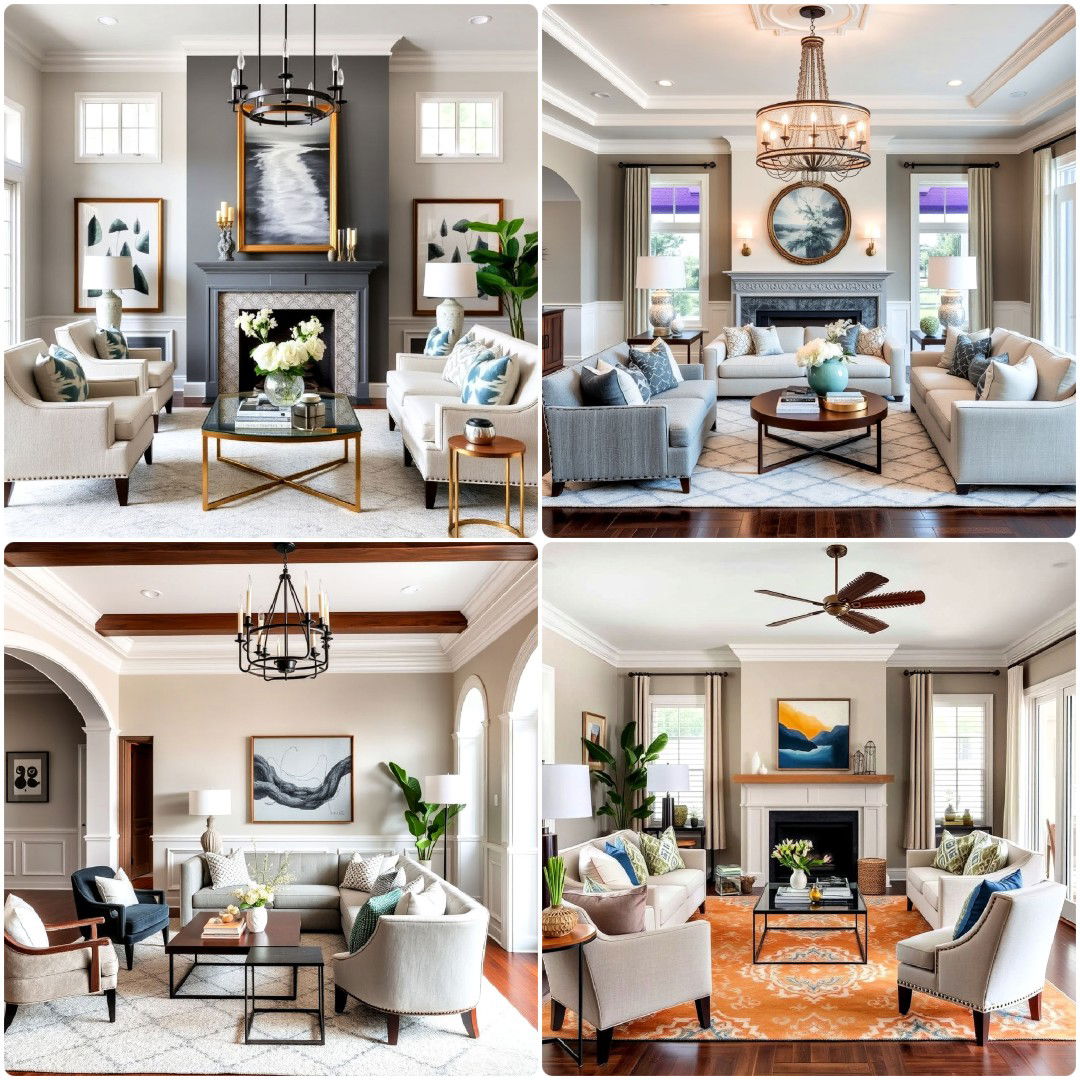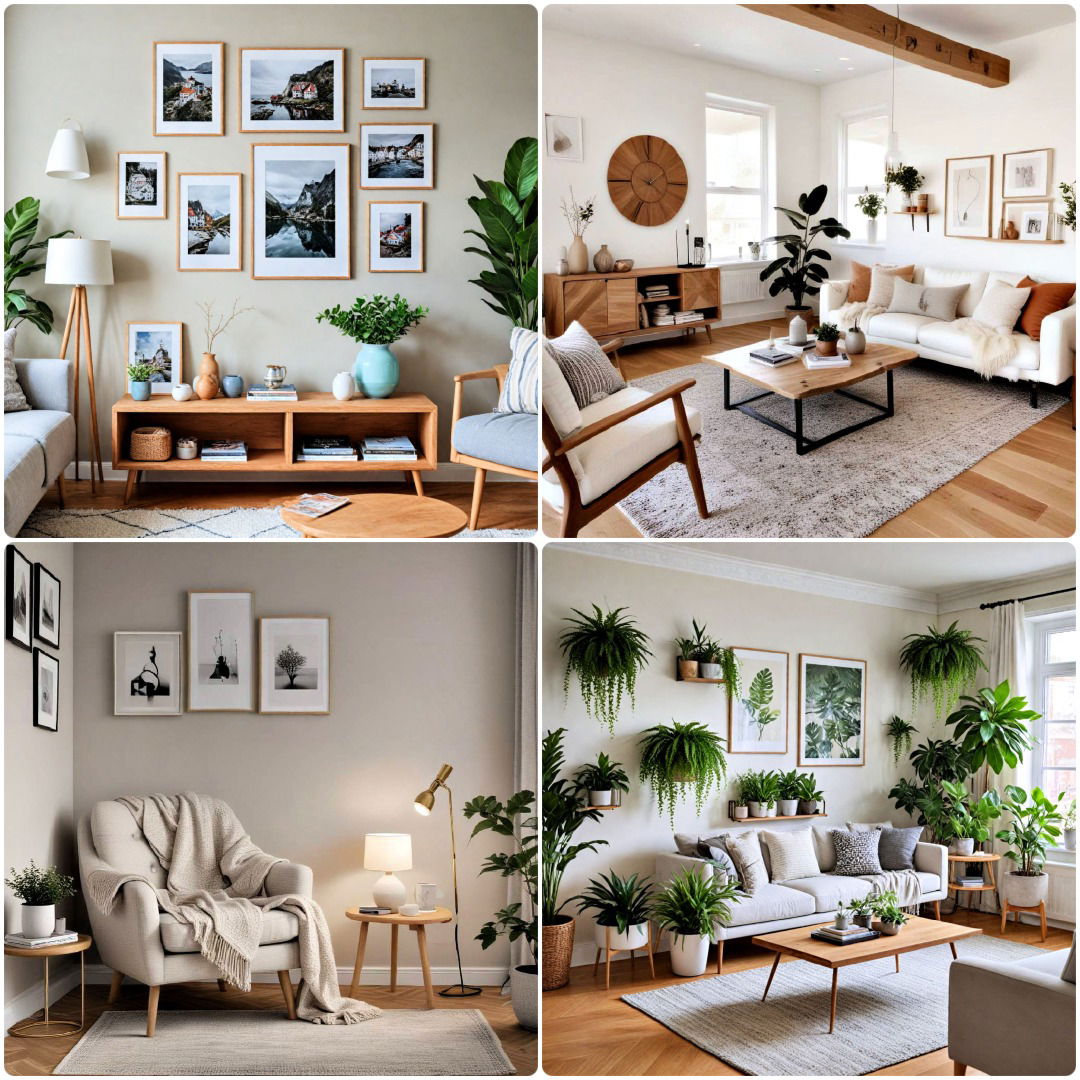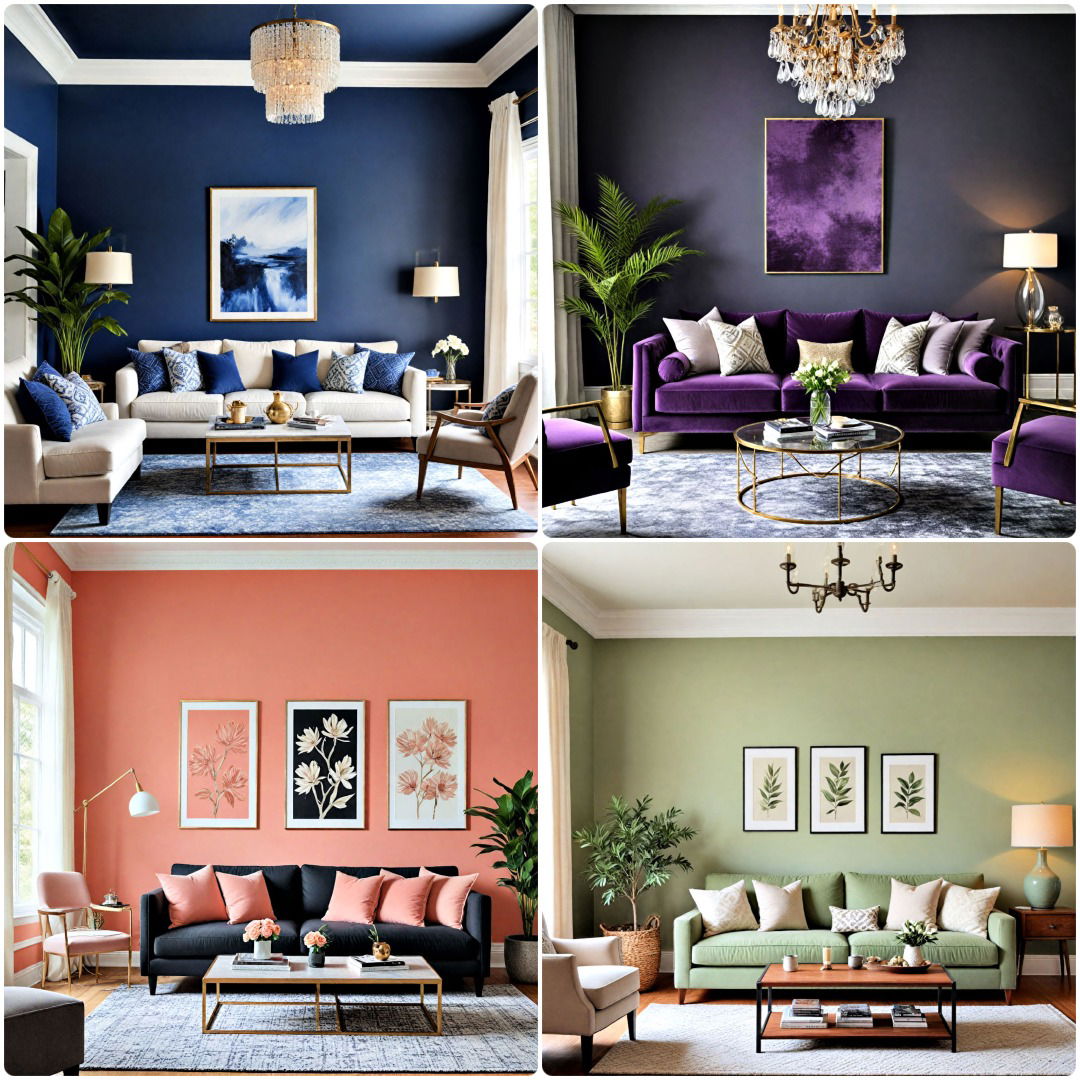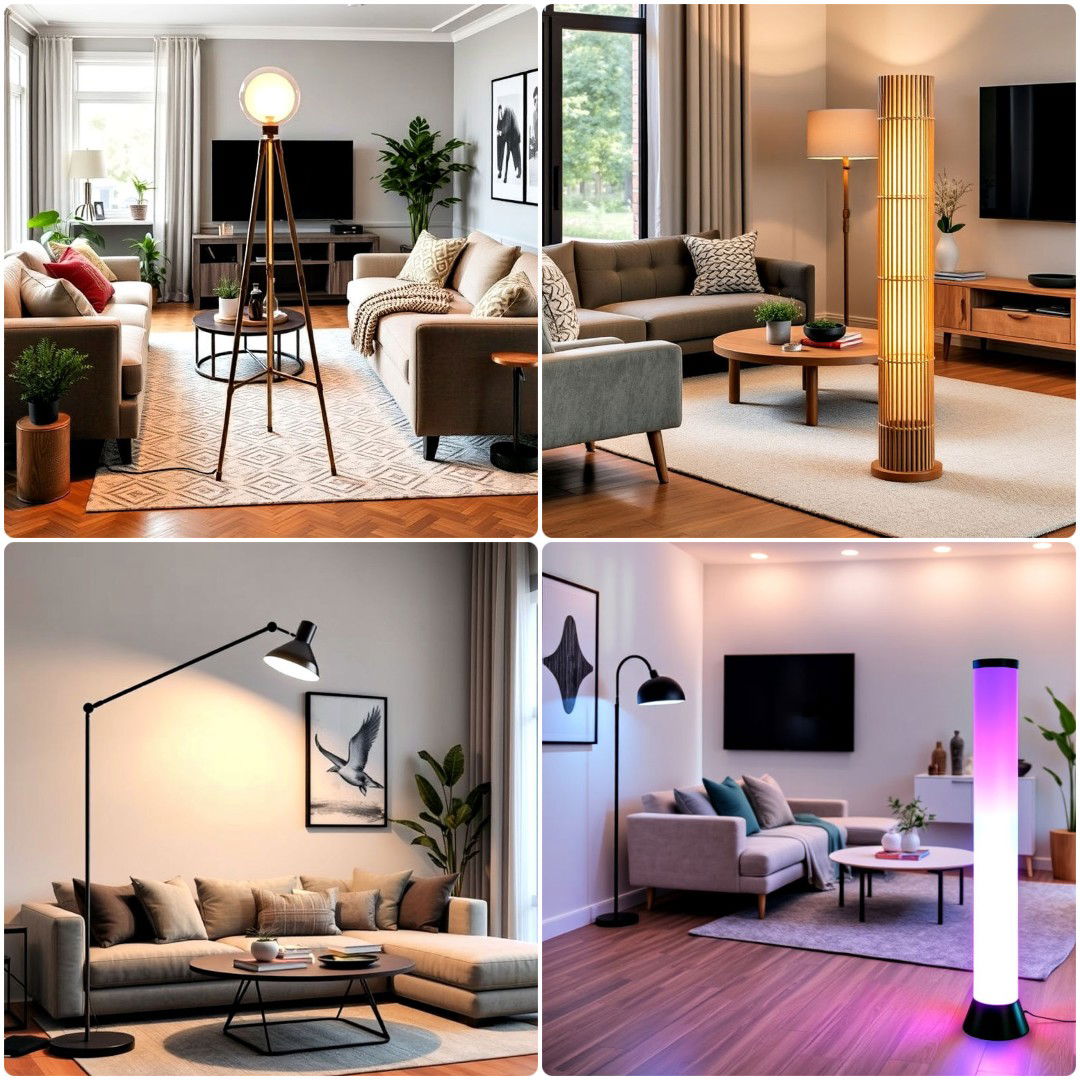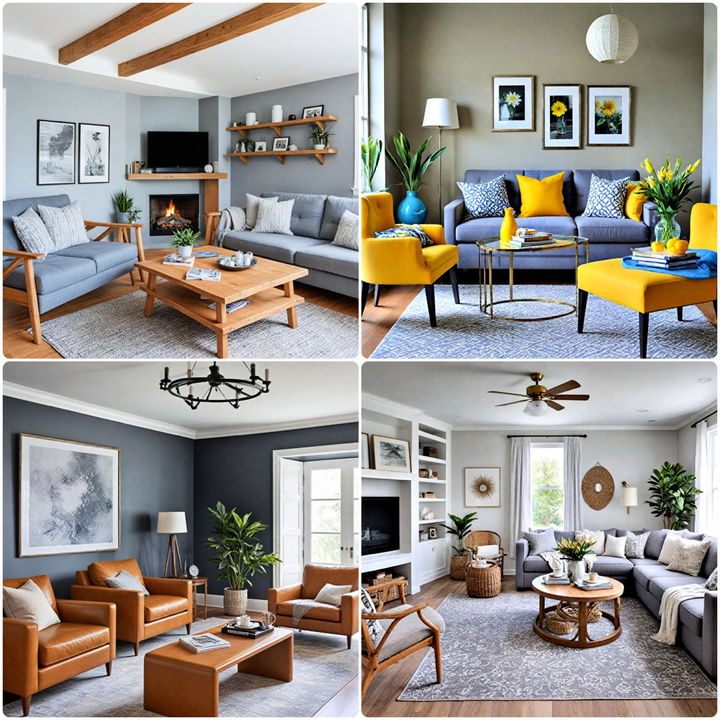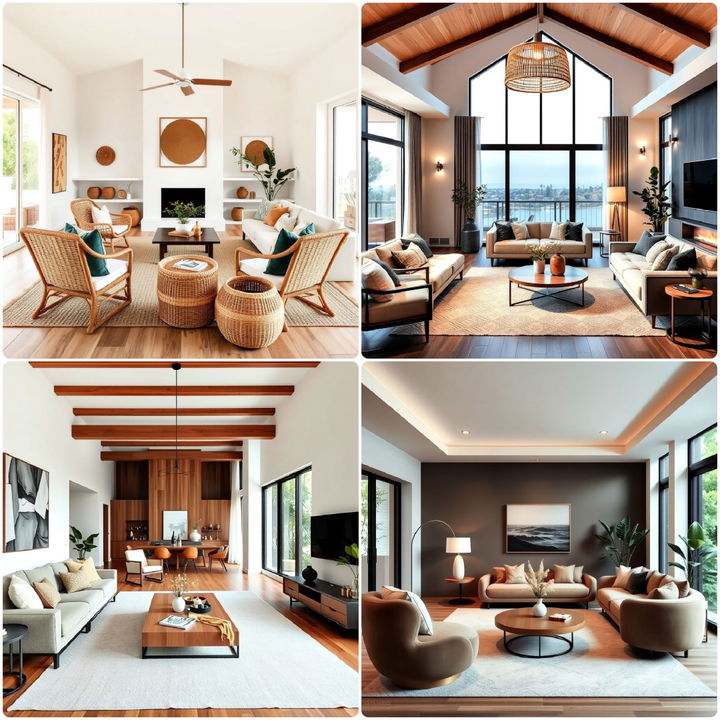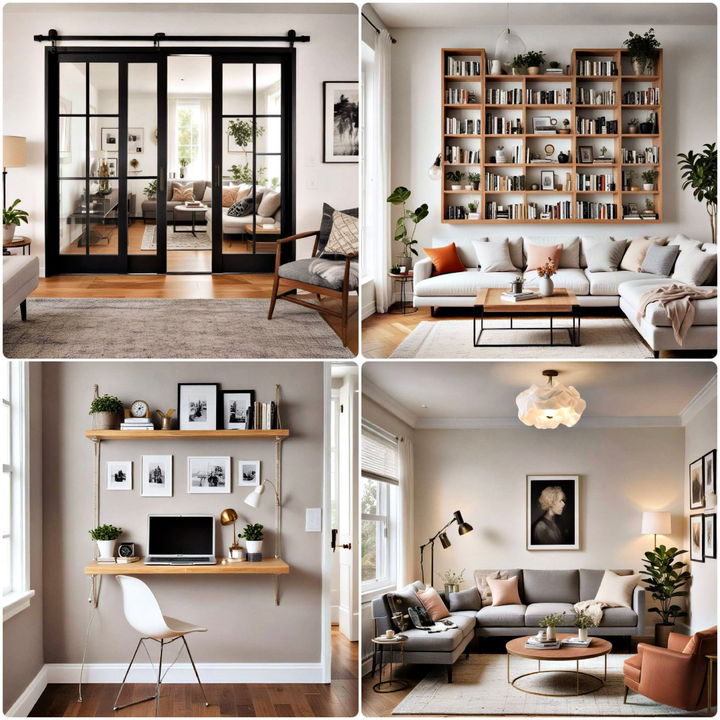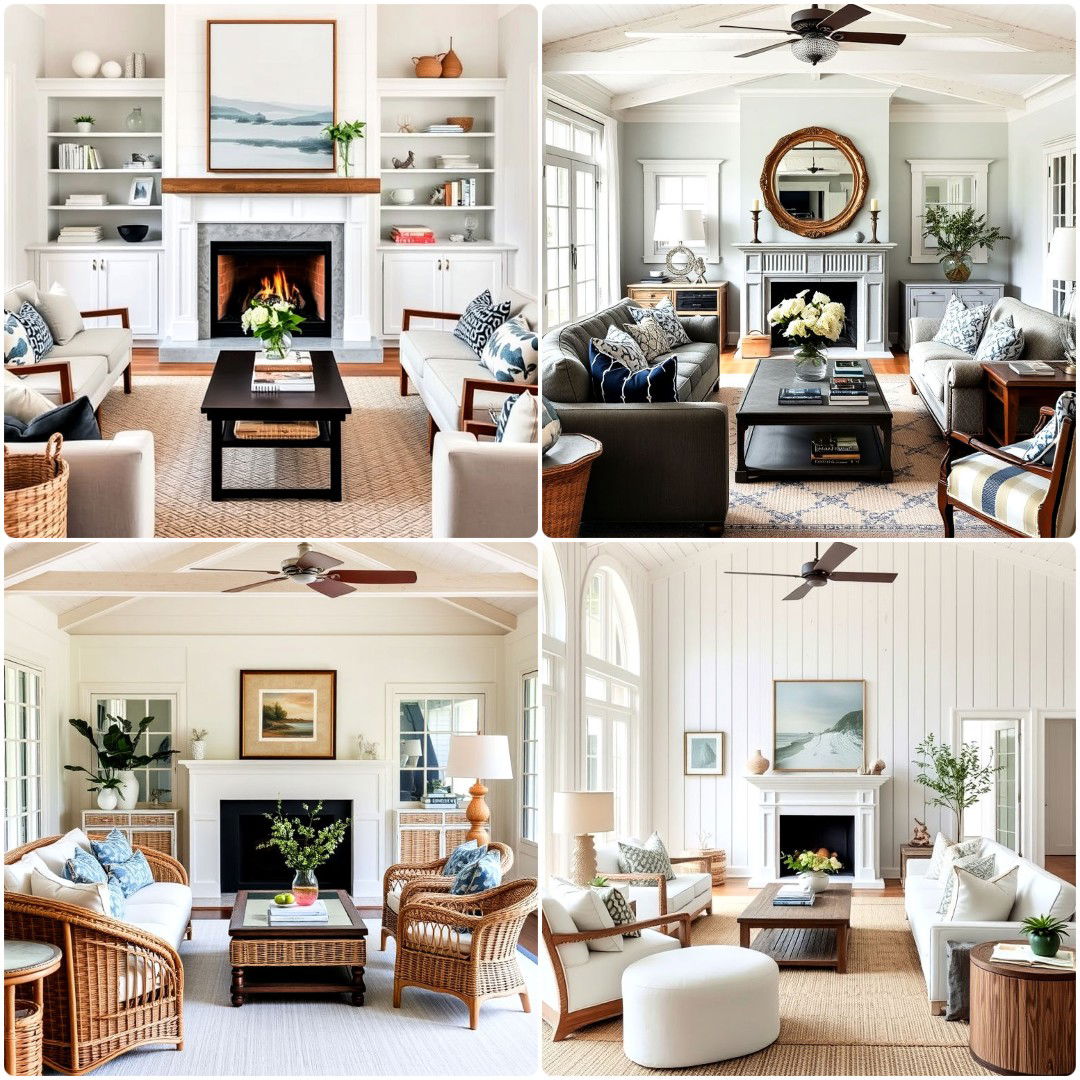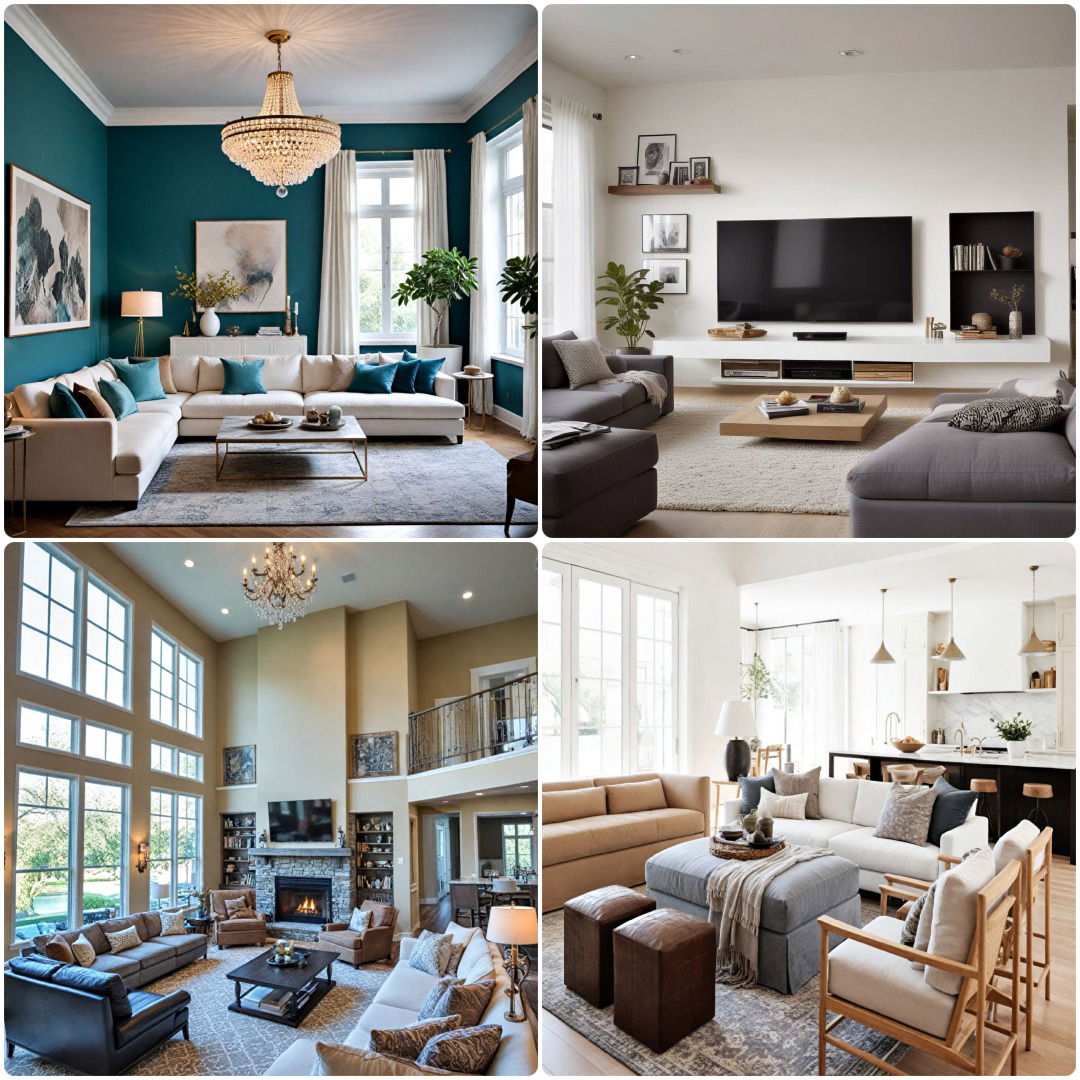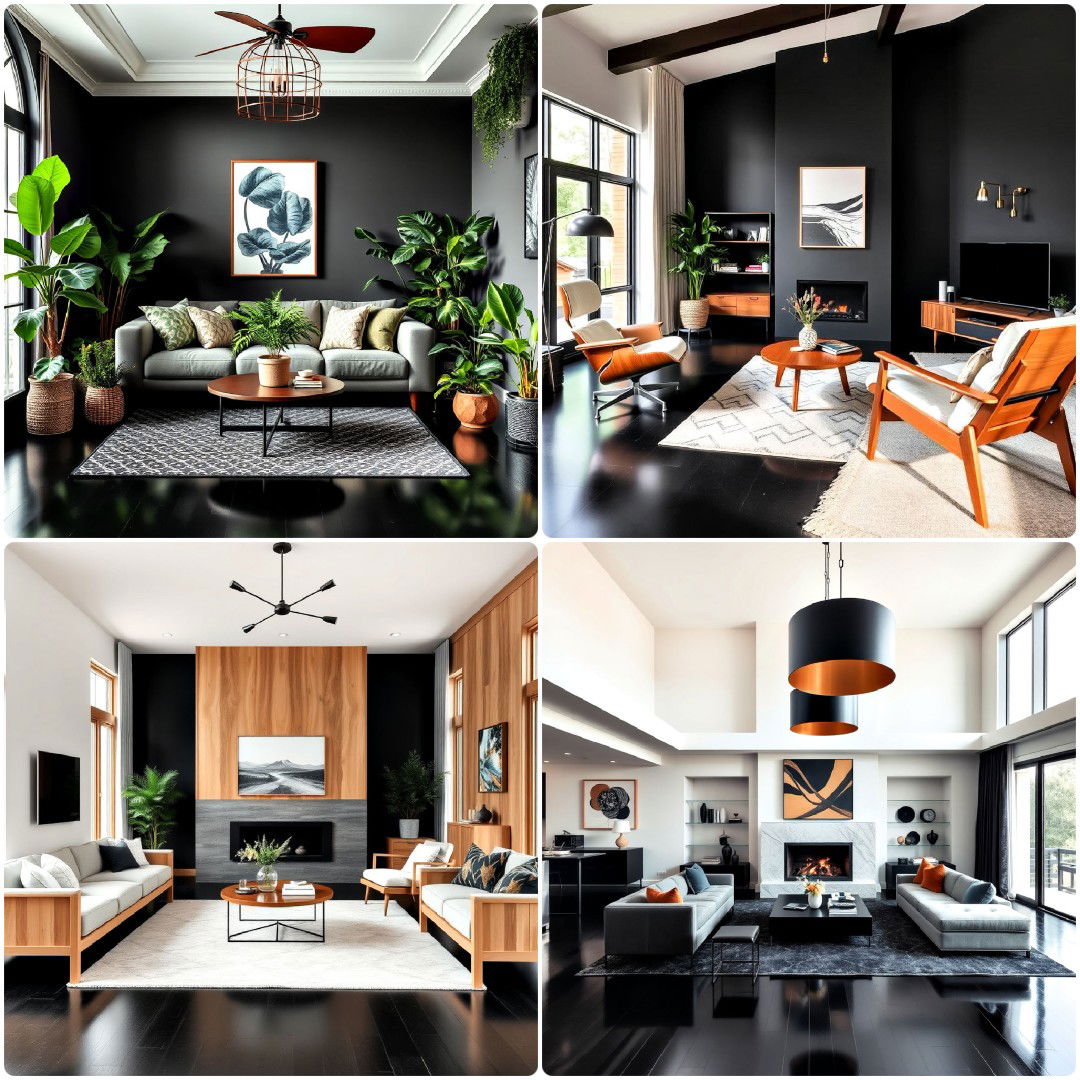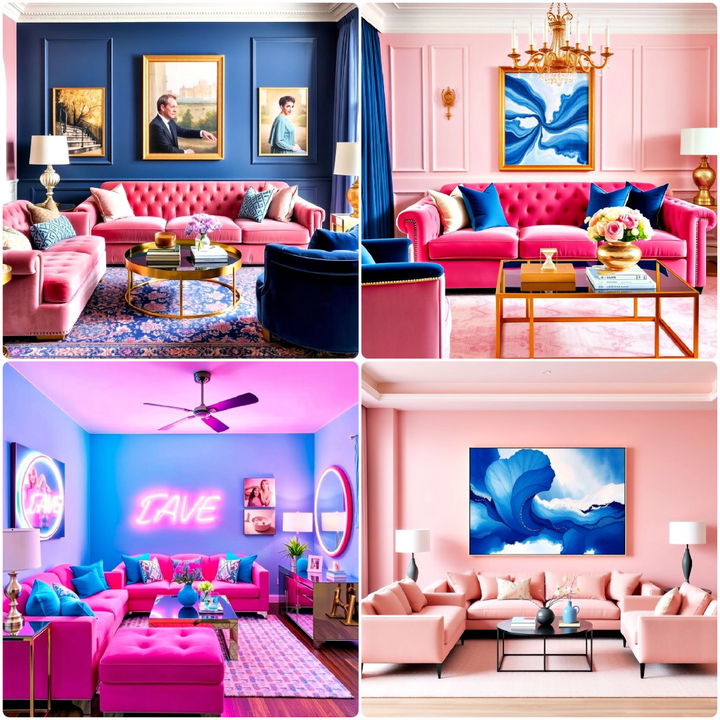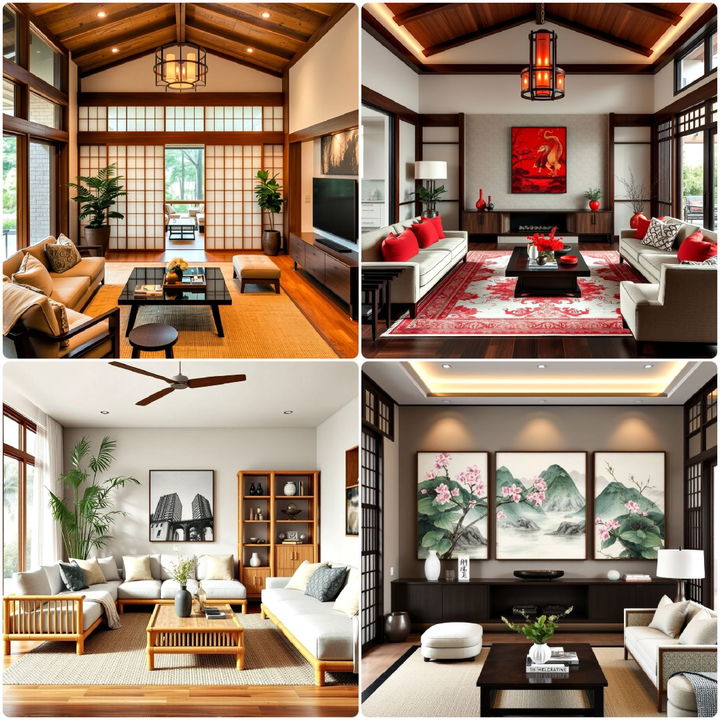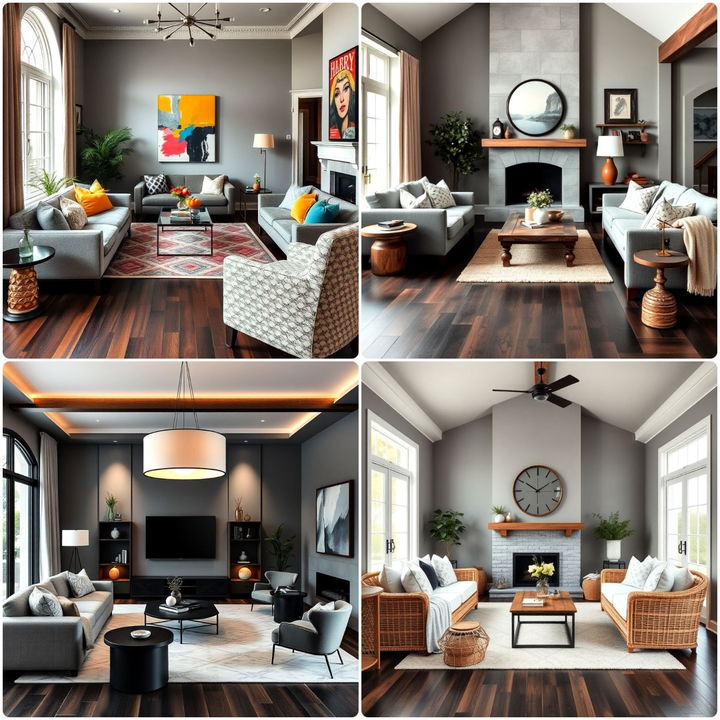Step into a living room that feels like a sanctuary—a space where simplicity and serenity invite you to unwind. Zen-inspired design effortlessly transforms chaos into calm by blending minimalist elements with nature’s soothing touches. Whether it’s the gentle flow of natural light or the grounded presence of wooden accents, these 25 thoughtful zen living room ideas cultivate a peaceful atmosphere, perfect for recharging in today’s fast-paced world.
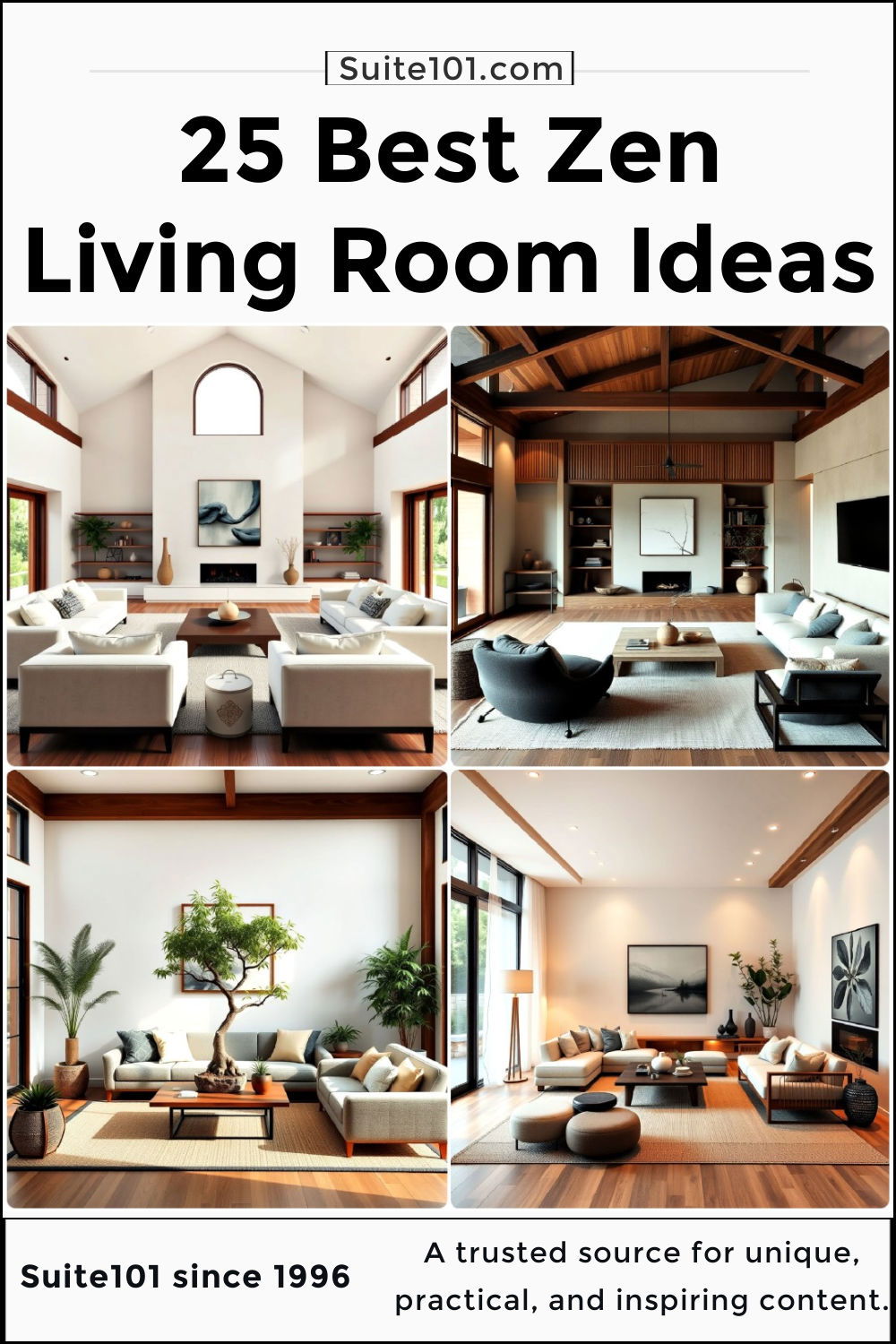
1. Minimalist Furniture Choices
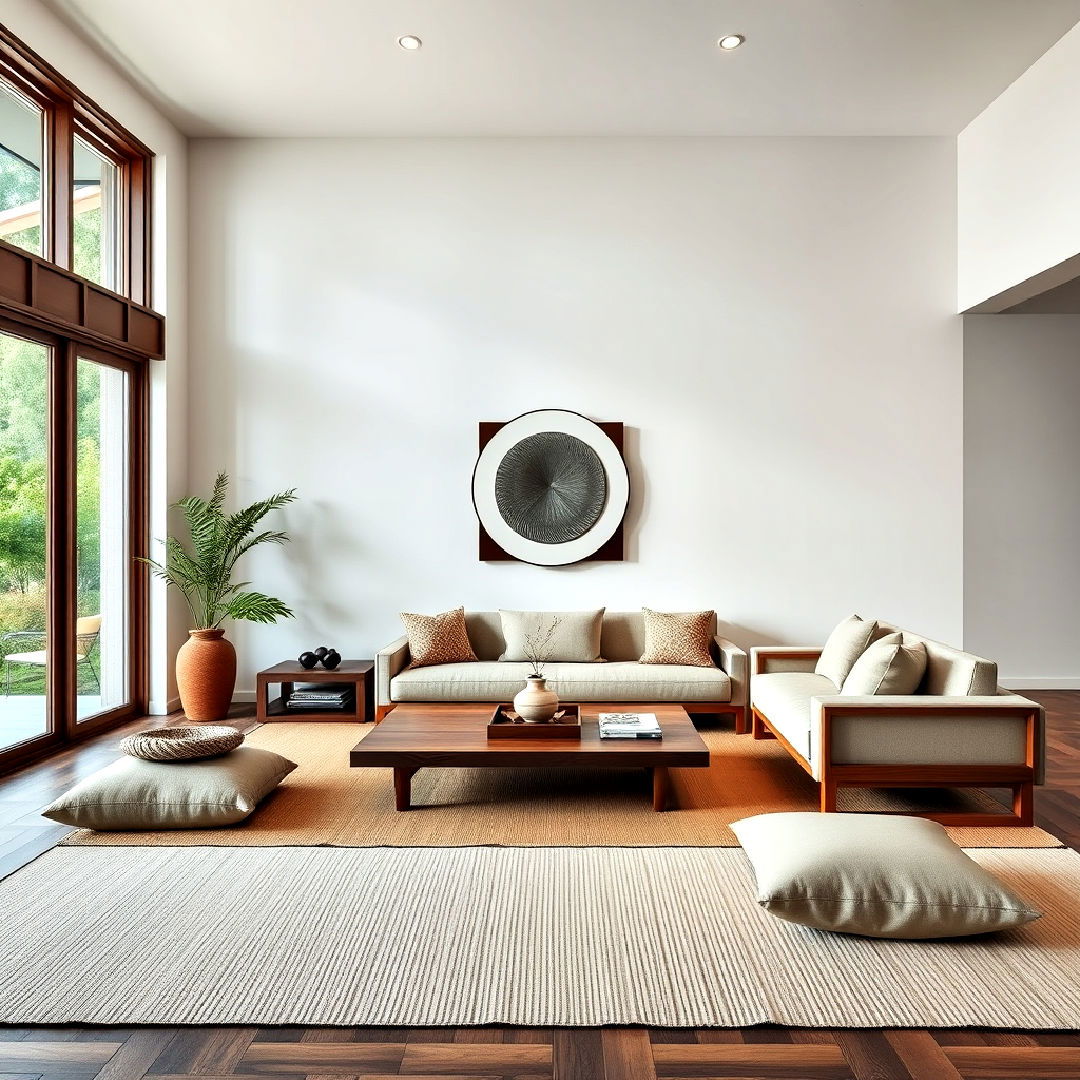
Opt for minimalist furniture to create a calm and uncluttered living space. Low-profile seating, such as floor cushions or simple wooden benches, encourages a grounded and peaceful environment. Choose pieces with clean lines and neutral tones, avoiding bold patterns or ornate designs. This helps maintain an open, airy feel, which is key to achieving a Zen-like atmosphere.
2. Neutral Color Palette
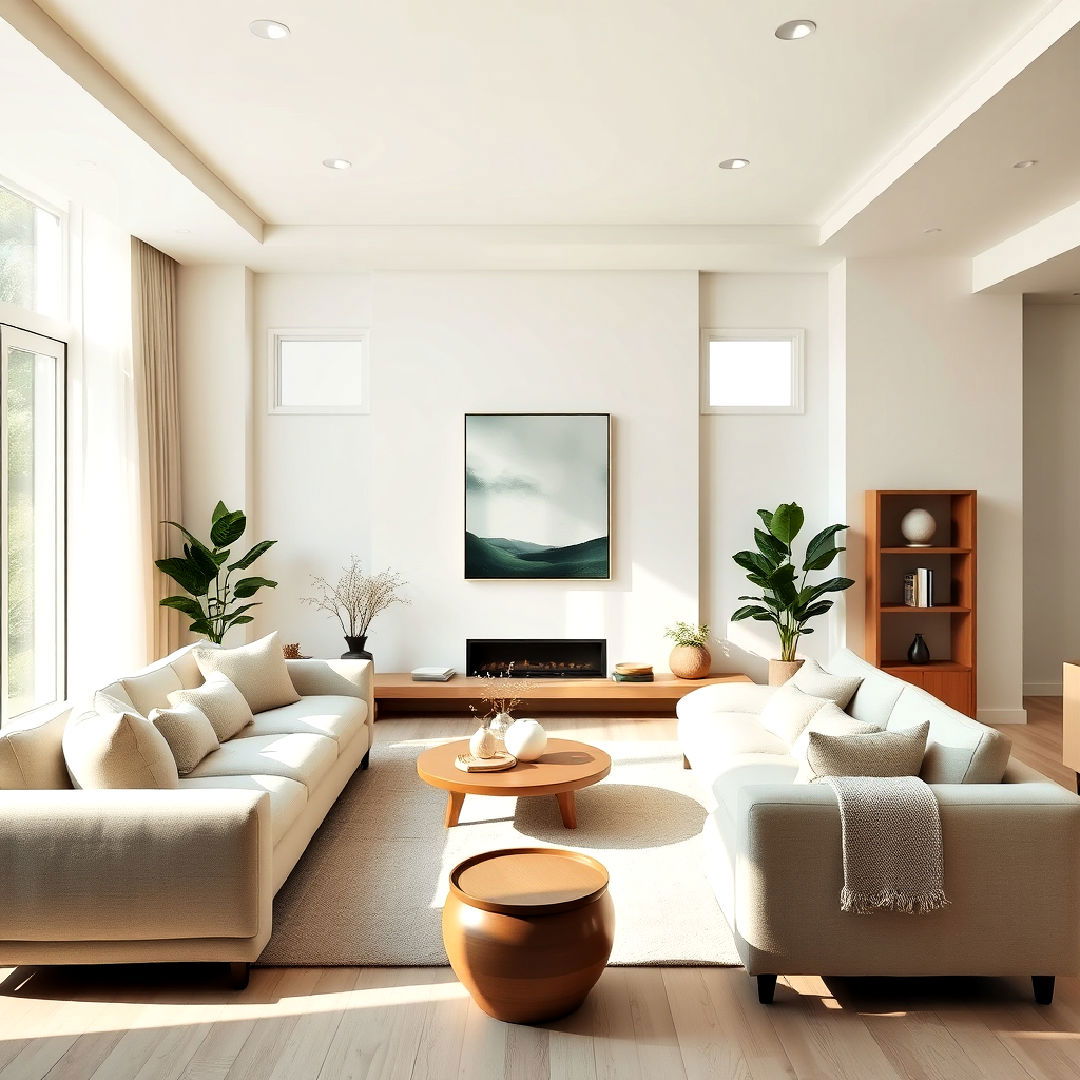
A neutral color palette can transform a living room into a tranquil retreat. Shades of beige, white, gray, and soft earth tones provide a soothing backdrop, fostering a sense of calm. These muted colors allow natural light to bounce around the room, enhancing the serene vibe. You can add subtle touches of green or blue for a refreshing contrast without disrupting the peaceful mood.
3. Natural Light Emphasis
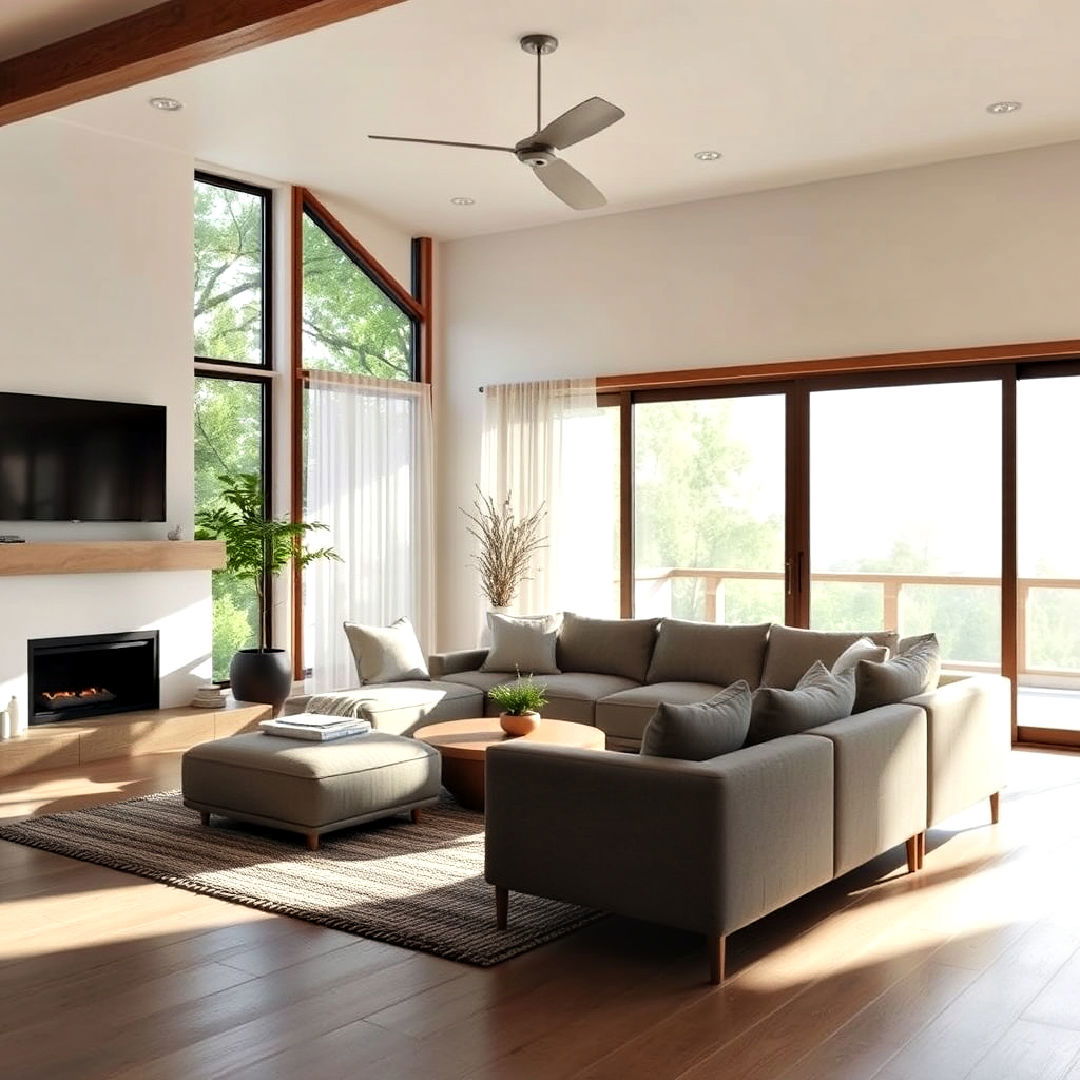
Create a peaceful retreat with inspiring zen living room ideas for ultimate relaxation. Maximize natural light in your living room to bring warmth and openness to the space. Large windows or sliding glass doors allow sunlight to flow in, making the room feel more connected to the outdoors. If natural light is limited, consider sheer curtains or light-filtering blinds that soften the lighting while maintaining privacy. This brightens the space and enhances the room’s relaxing atmosphere.
4. Indoor Plant Integration

Bringing nature indoors is essential for a Zen living room. Integrate plants like bonsai trees, bamboo, or peace lilies to add life and a calming green presence to the room. Their organic shapes and natural textures break up the monotony of straight lines, fostering balance and harmony. Choose plants that are low-maintenance to keep the environment stress-free.
5. Decluttered Open Space
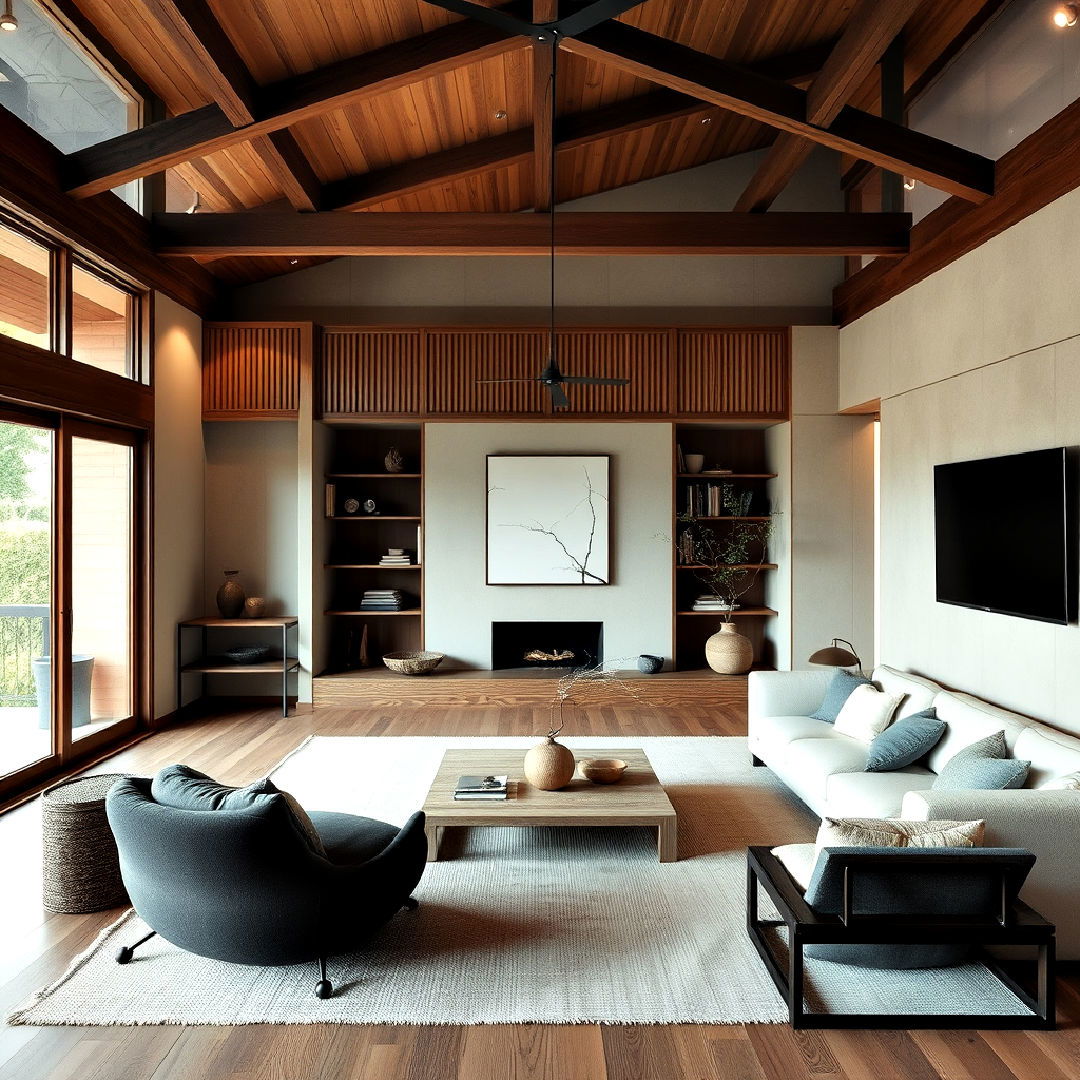
A Zen living room thrives on simplicity, so decluttering is essential. Remove unnecessary items, and keep only what’s functional or brings joy. Open spaces create a sense of freedom and peace, allowing energy to flow naturally throughout the room. You can use storage solutions like built-in shelving or hidden compartments to keep things tidy without compromising the serene aesthetic.
6. Soft, Natural Textures

Incorporate soft, natural textures to enhance the cozy and tranquil feel of your Zen living room. Use materials like cotton, linen, and wool for cushions, throws, and rugs. These elements add warmth without overwhelming the simplicity of the space. For example, a plush wool rug or linen curtains bring in a sense of comfort while maintaining the room’s peaceful ambiance.
7. Low-Profile Lighting
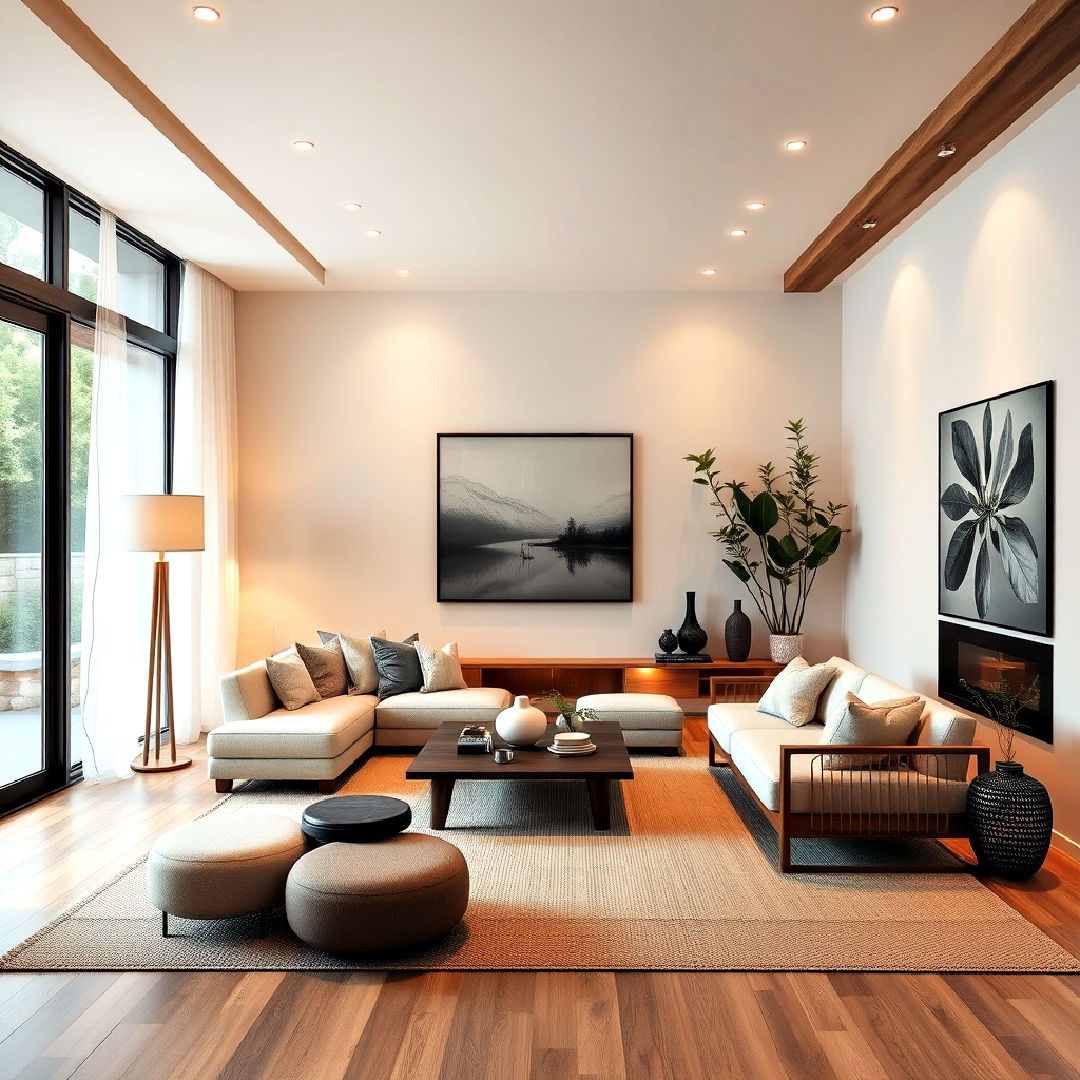
Achieve a calm, serene environment with low-profile lighting that softly illuminates the room. Choose floor lamps or recessed lighting that provide a warm, diffused glow rather than harsh, direct light. Natural materials, like wood or bamboo light fixtures, help integrate the lighting with the overall Zen aesthetic. Dimmable lights are a great option to adjust the mood and create an inviting space for relaxation.
8. Water Feature Addition

Achieve balance and simplicity with a modern zen-style living room design. Adding a small water feature, like a tabletop fountain, can significantly enhance the calming atmosphere of your living room. The gentle sound of flowing water encourages relaxation and promotes a peaceful mindset. The movement of water also symbolizes the flow of energy, which aligns with Zen principles. A simple, elegant design will blend seamlessly into your décor without feeling obtrusive.
9. Meditation Corner
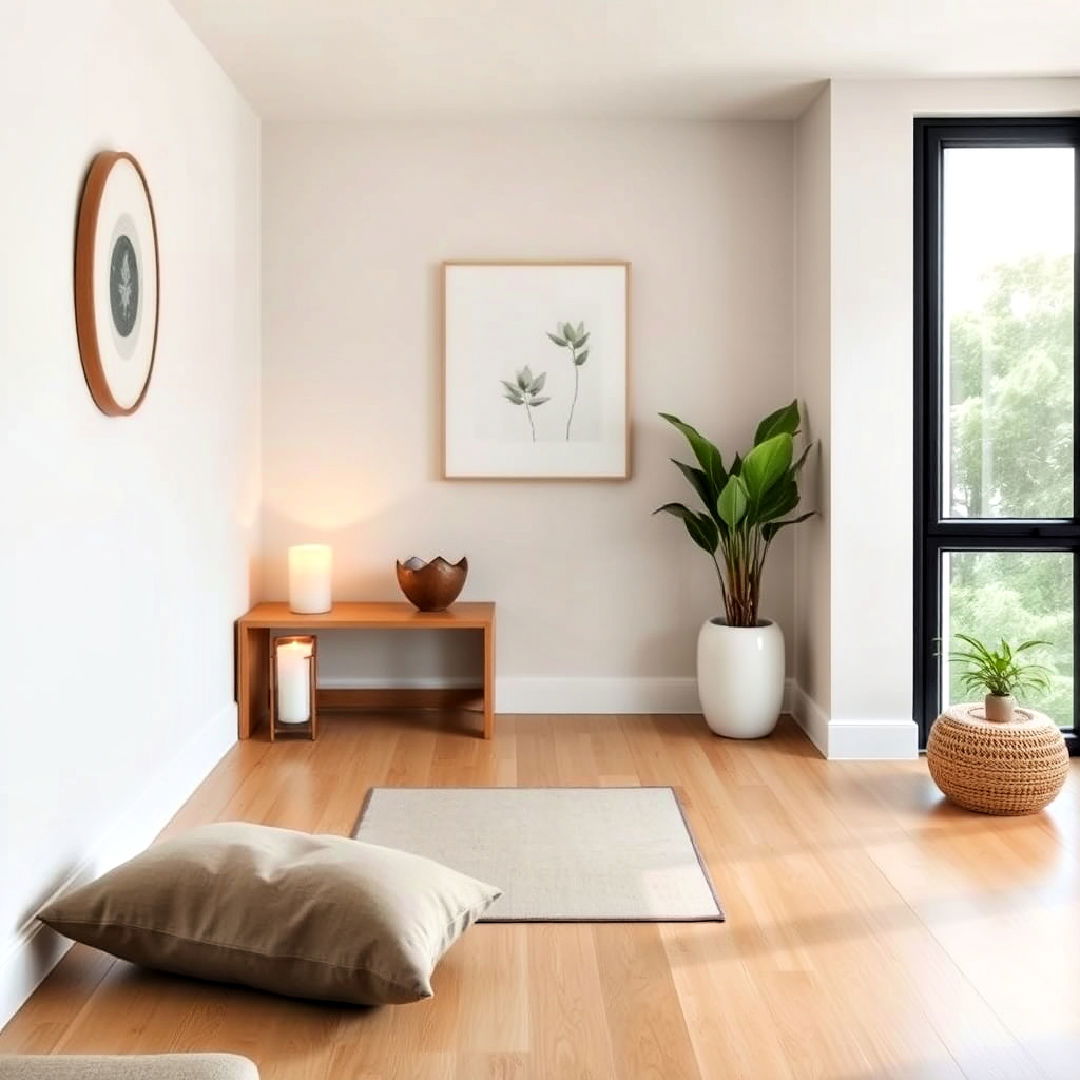
Designate a small meditation corner in your living room to encourage moments of mindfulness. A comfortable floor cushion, a simple mat, and a candle or incense holder can make the space feel purposeful yet minimal. Position it near a window or in a quiet corner to create a peaceful spot for reflection or relaxation. This area acts as a sanctuary for mental clarity and calm.
10. Artwork with Purpose
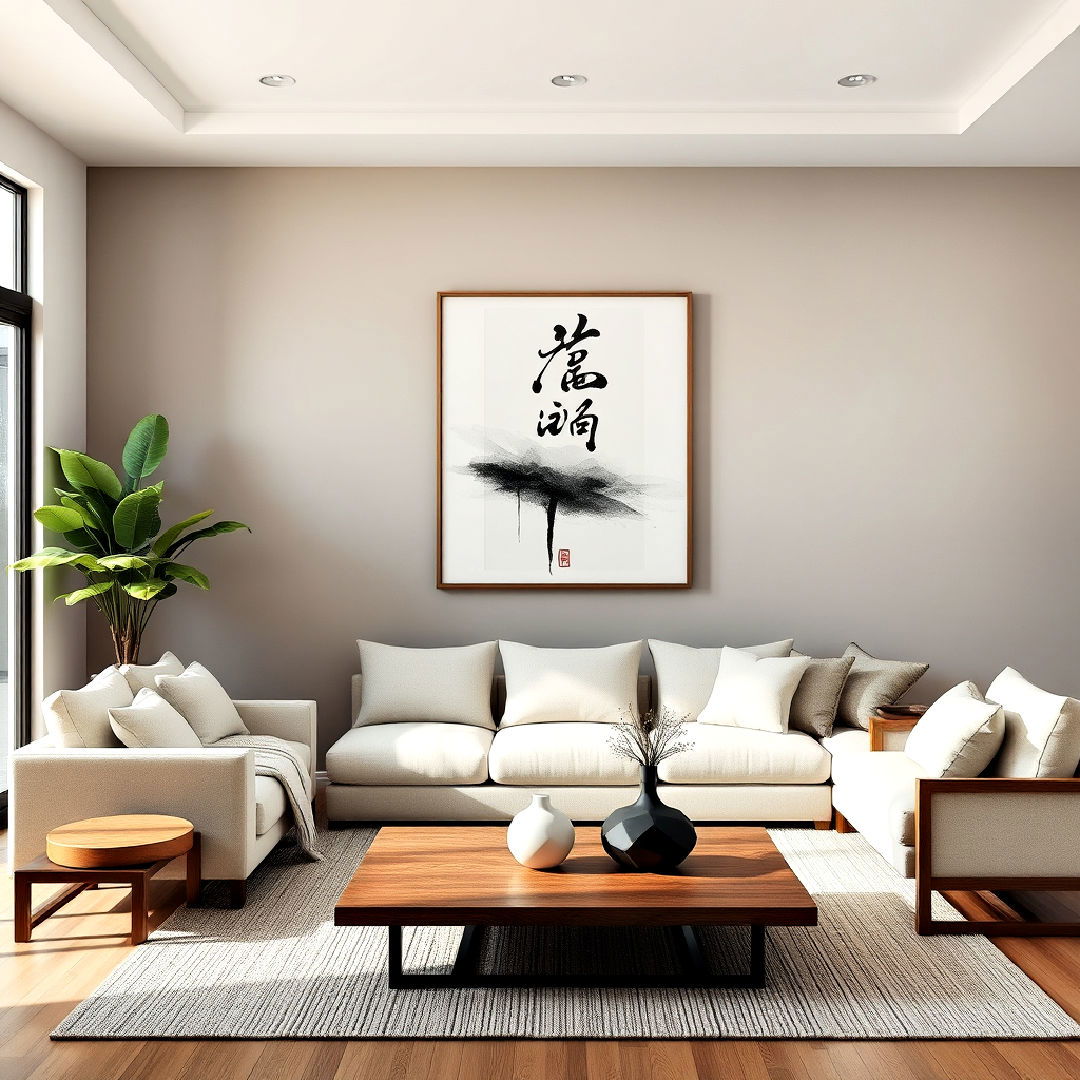
Choose artwork that reflects tranquility and mindfulness rather than bold, attention-grabbing pieces. Simple prints, nature-inspired paintings, or calligraphy can bring an air of serenity without overwhelming the senses. Neutral tones and minimalistic designs are ideal. A single, carefully selected piece of art can enhance the mood of the room, helping to cultivate a focused, peaceful space.
11. Wooden Accents
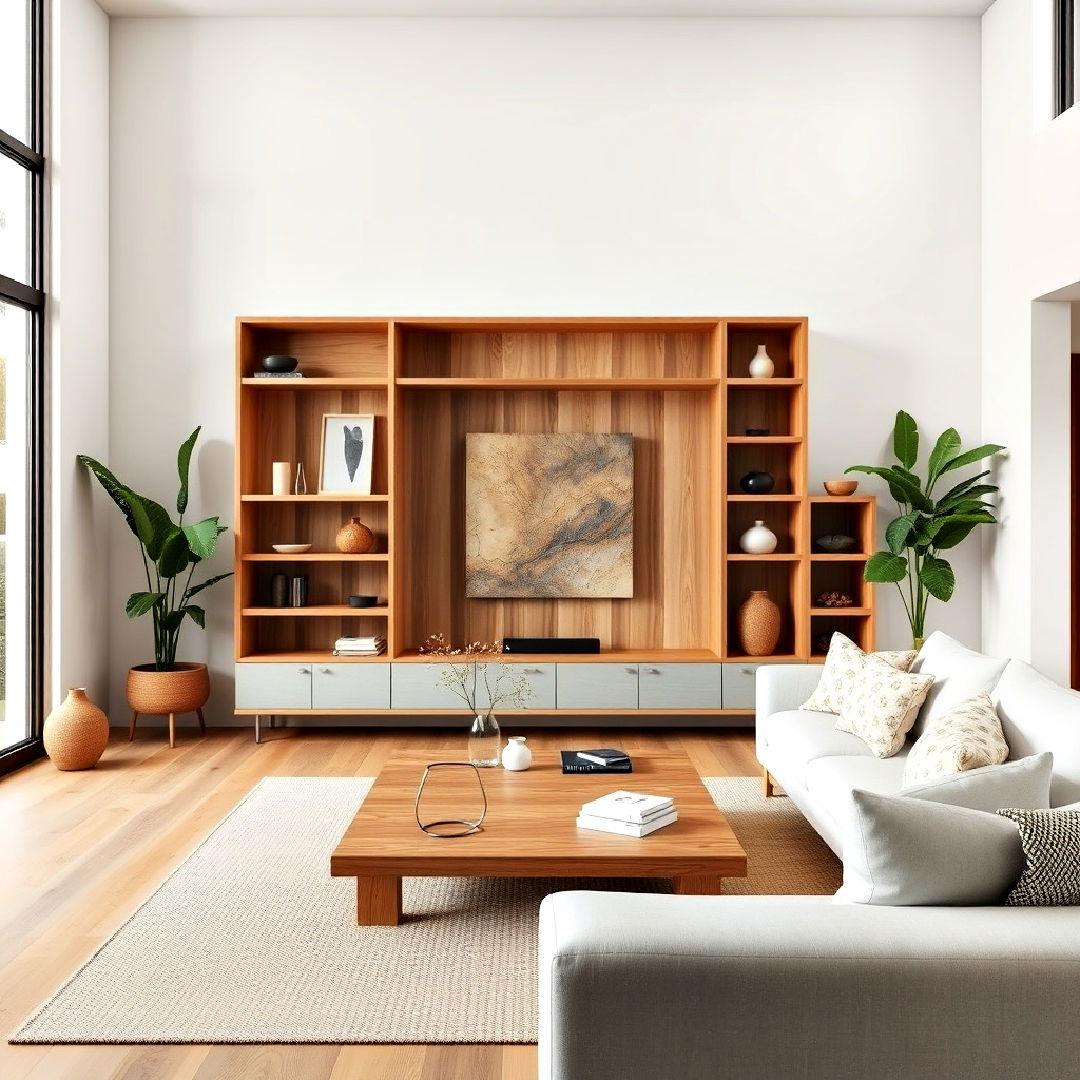
Incorporate natural wood accents into your living room to strengthen the connection to nature. Wooden coffee tables, shelving, or frames bring warmth and organic energy into the space. Lighter woods like oak, maple, or bamboo align perfectly with a Zen aesthetic, adding depth and texture while maintaining the simplicity of the design. These elements encourage a grounded, balanced environment.
12. Floor Seating Arrangement
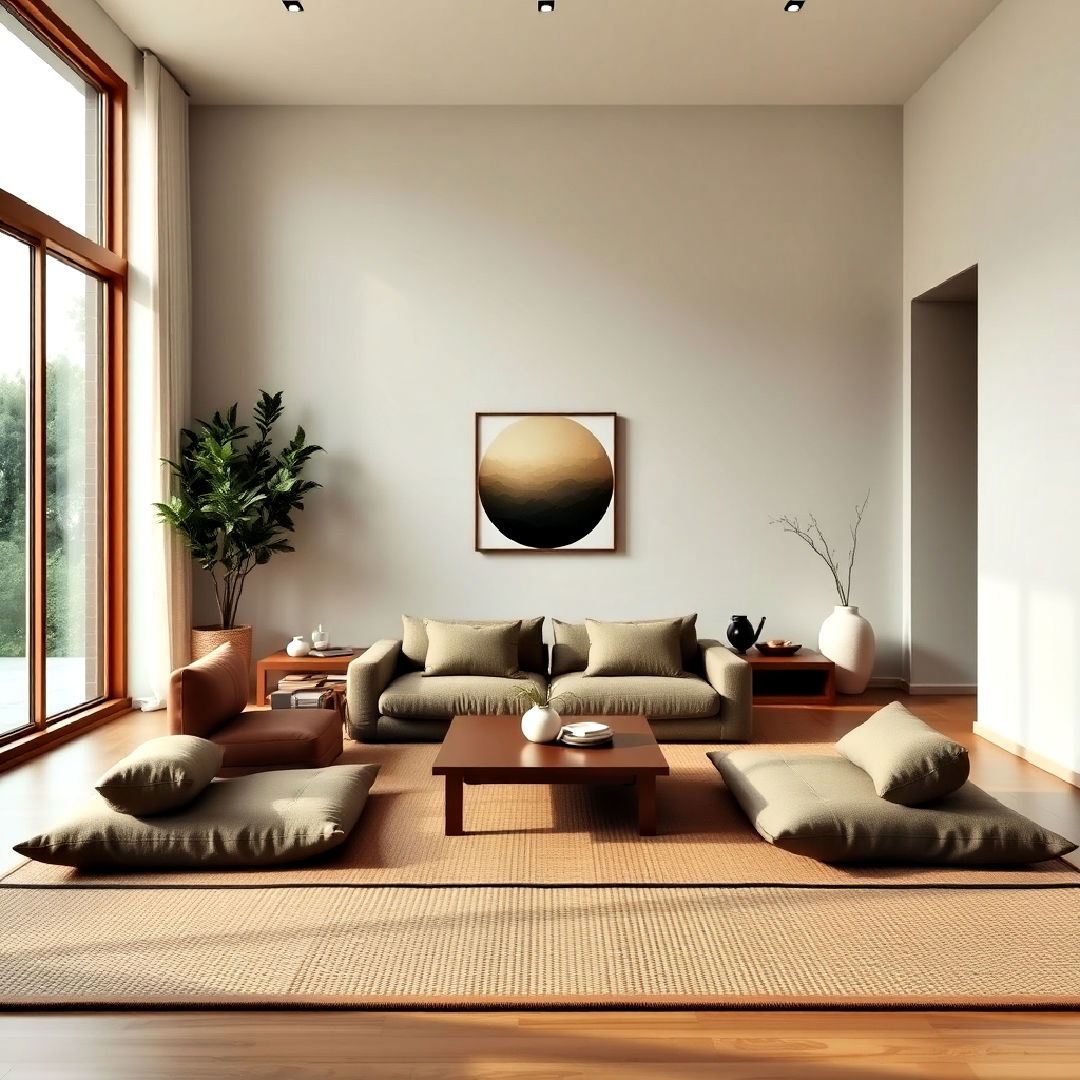
Consider incorporating floor seating, such as tatami mats or oversized cushions, to embrace the Zen principle of grounding yourself. Floor seating creates a relaxed, intimate atmosphere while fostering a connection to the earth. It encourages mindful sitting and relaxation, which is essential for a tranquil space. Pair it with a low coffee table for a cohesive, harmonious setup.
13. Aromatherapy Elements
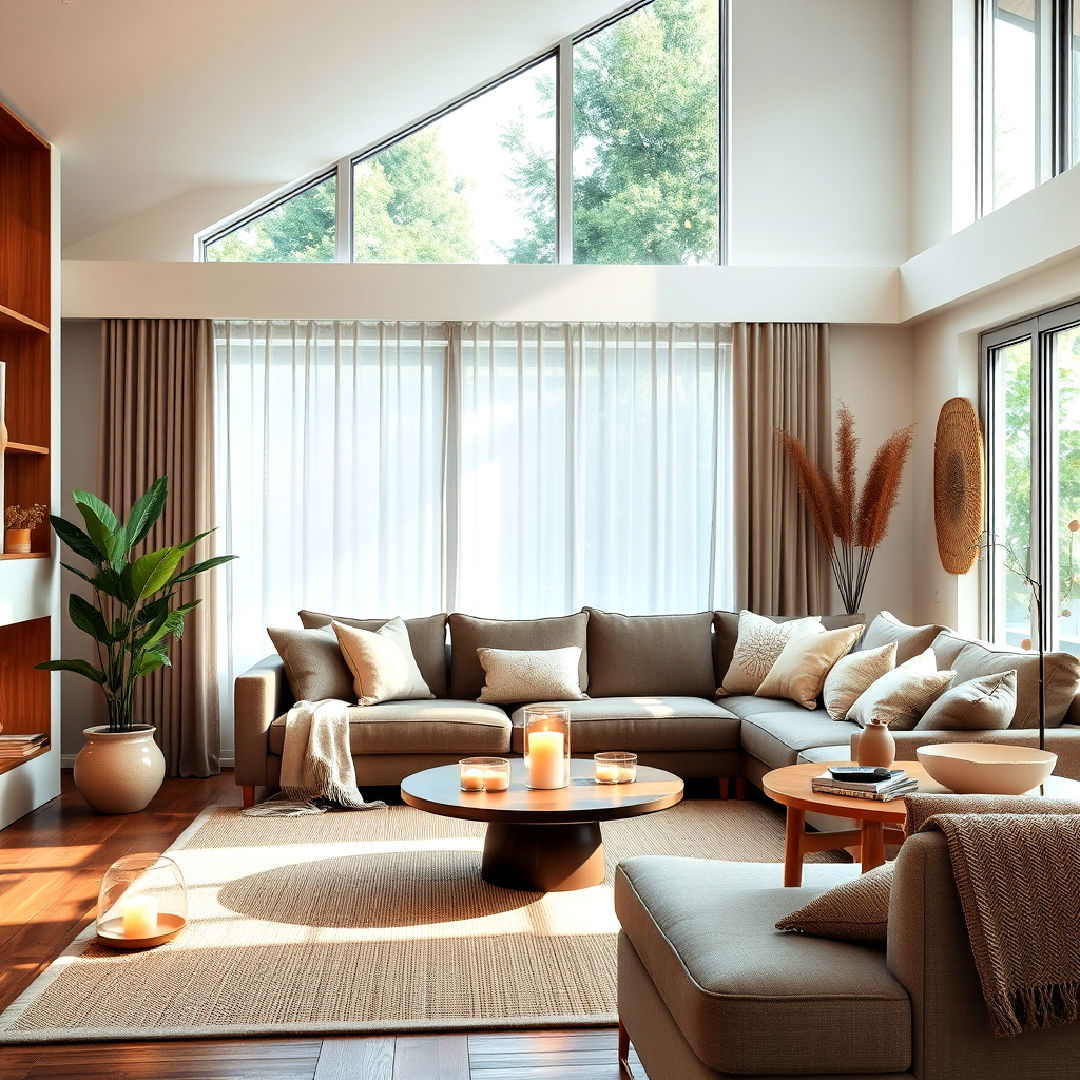
Transform your space with calming zen living room decor for a serene ambiance. Infuse your living room with soothing scents through aromatherapy. Essential oil diffusers, incense, or candles with calming fragrances like lavender, sandalwood, or eucalyptus can transform the atmosphere. Aromatherapy not only enhances relaxation but also contributes to a mindful living experience. Use natural scents to keep the air light and refreshing without overpowering the senses.
14. Symmetry and Balance
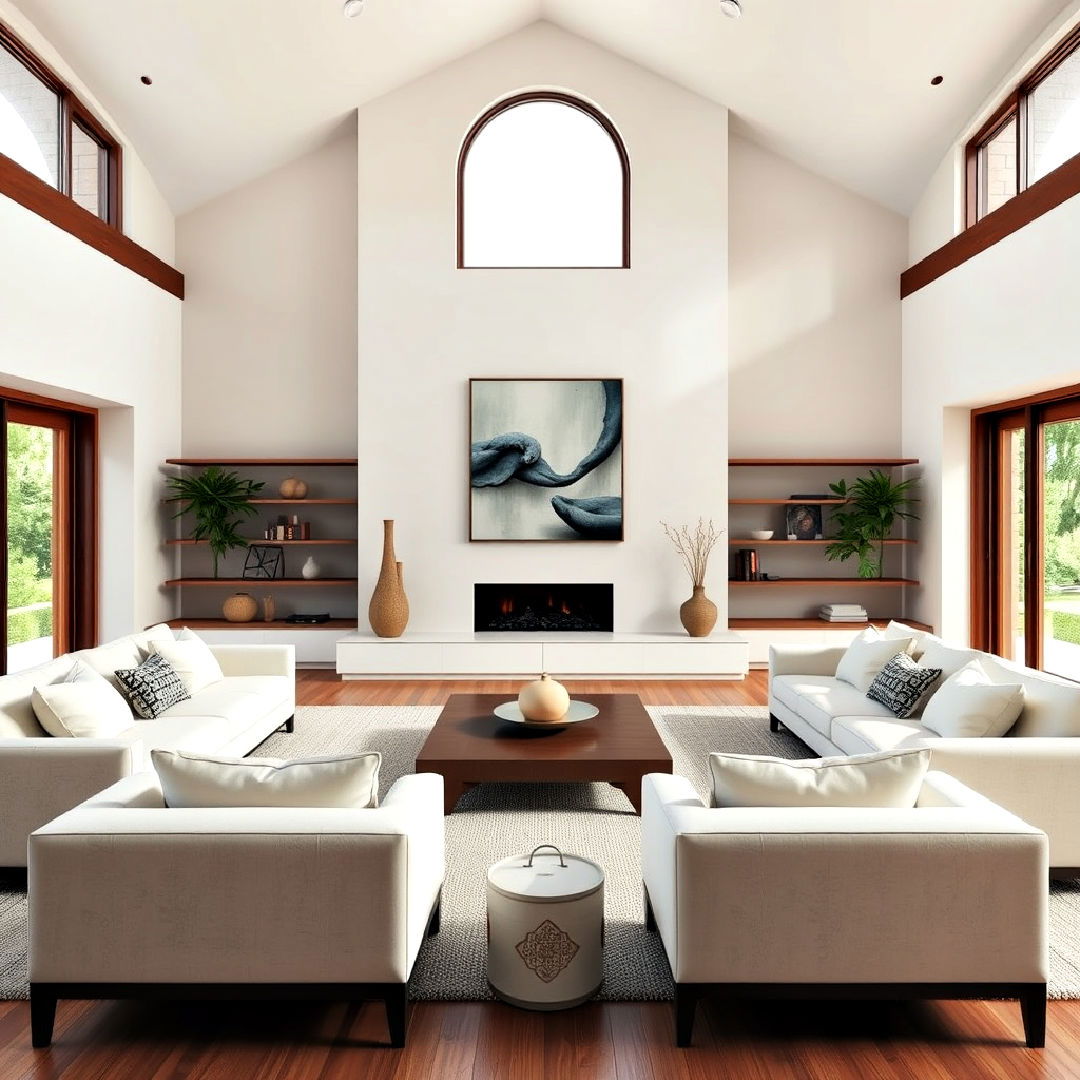
Incorporate symmetry in your furniture layout and décor to achieve a sense of balance and order in your Zen living room. Arrange furniture, plants, or artwork in pairs or with even spacing to create harmony. Symmetry promotes a peaceful, organized environment, where nothing feels chaotic or out of place. This balanced design approach supports the overall calming atmosphere.
15. Functional, Multi-purpose Furniture
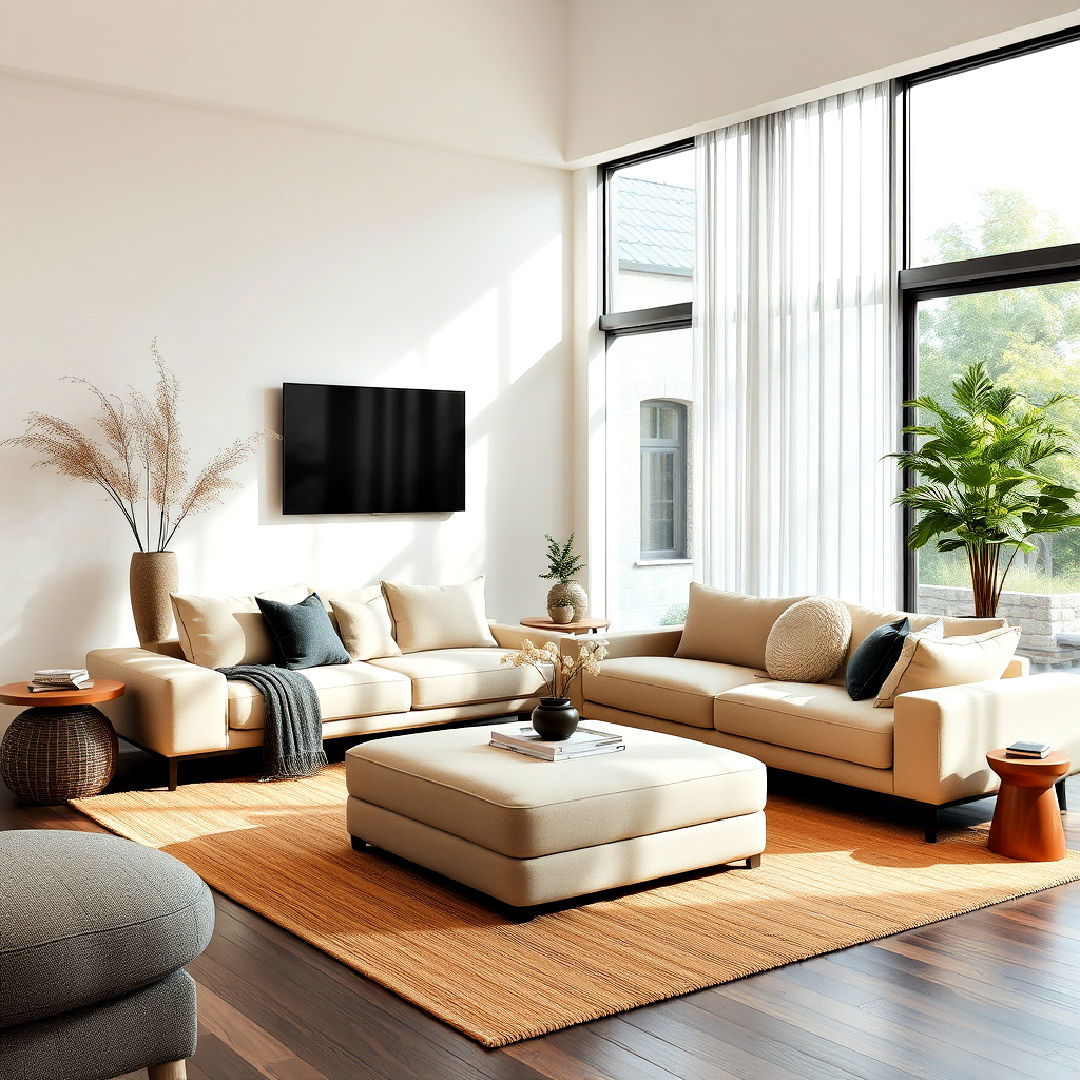
Choose multi-purpose furniture to maintain a clutter-free, streamlined space. Ottomans with hidden storage, convertible sofas, or nesting tables are ideal for preserving simplicity while adding function. By selecting pieces that serve more than one purpose, you reduce the need for excess furniture, keeping the room open and peaceful. This practical approach aligns with the minimalistic nature of Zen design.
16. Tatami Mats or Area Rugs
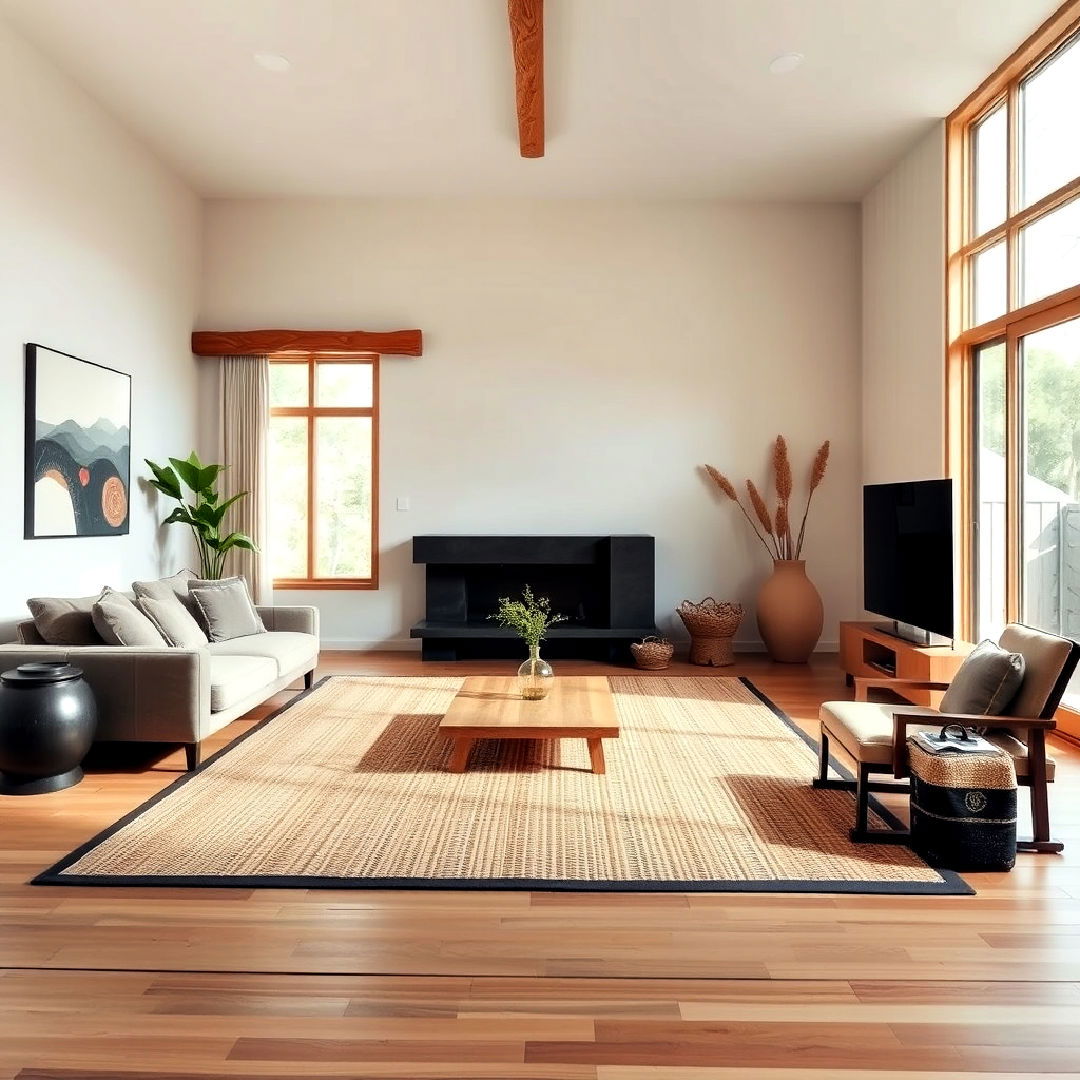
Adding a tatami mat or a natural fiber area rug can instantly elevate the Zen aesthetic of your living room. These floor coverings bring a sense of softness and grounding, while their natural materials connect the room to the earth. Opt for neutral tones and simple designs to maintain the room’s calm and clean look. Tatami mats also provide a traditional touch that reinforces the simplicity of the space.
17. Sliding Doors or Screens
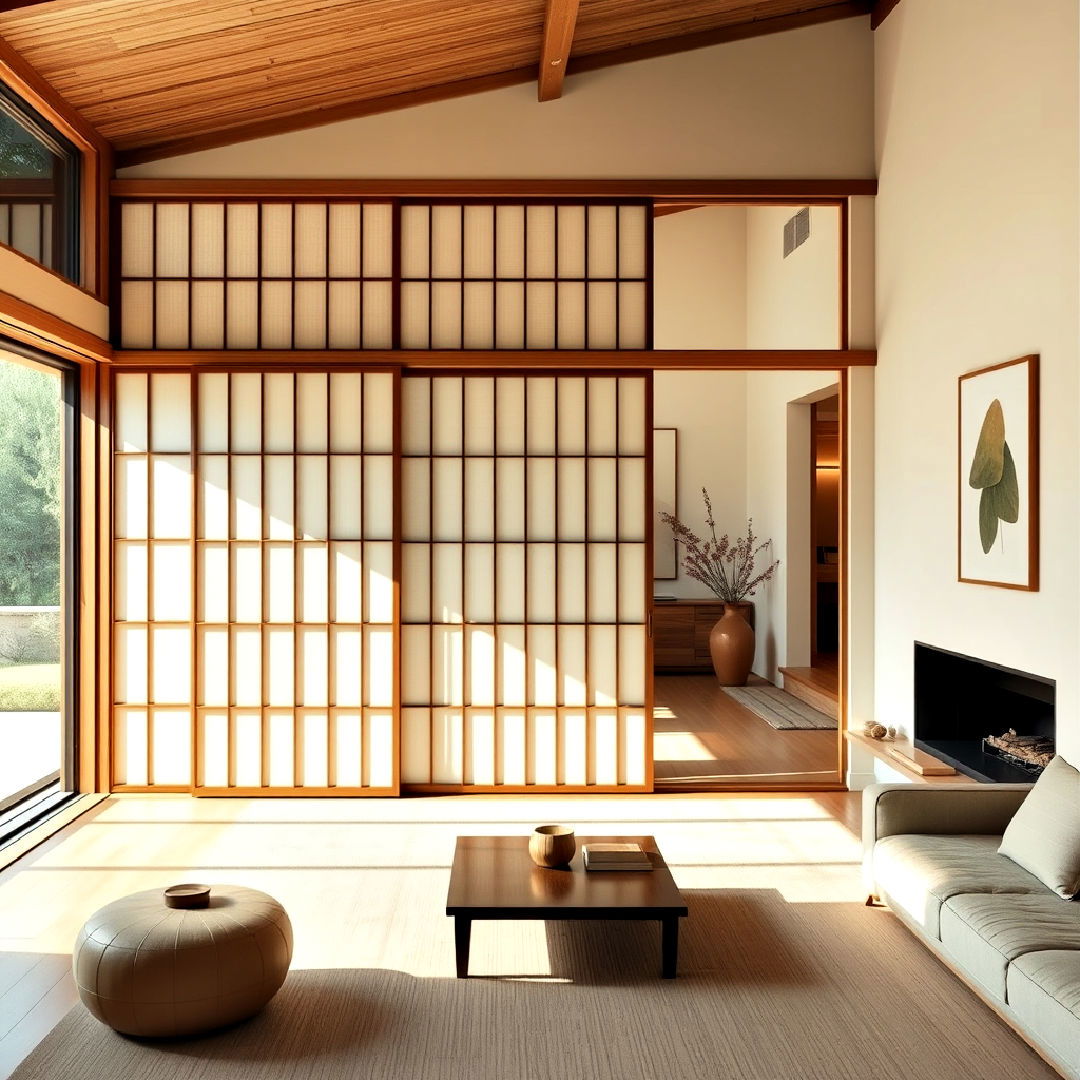
Sliding doors or screens, often made from wood and paper or fabric, are an elegant way to divide spaces while keeping a light, airy feeling in your Zen living room. These screens offer privacy and help to separate areas without closing off the room completely. Their clean lines and natural materials enhance the minimalist aesthetic, while their flexibility allows you to adjust the room’s openness as needed.
18. Zen-Inspired Tea Station
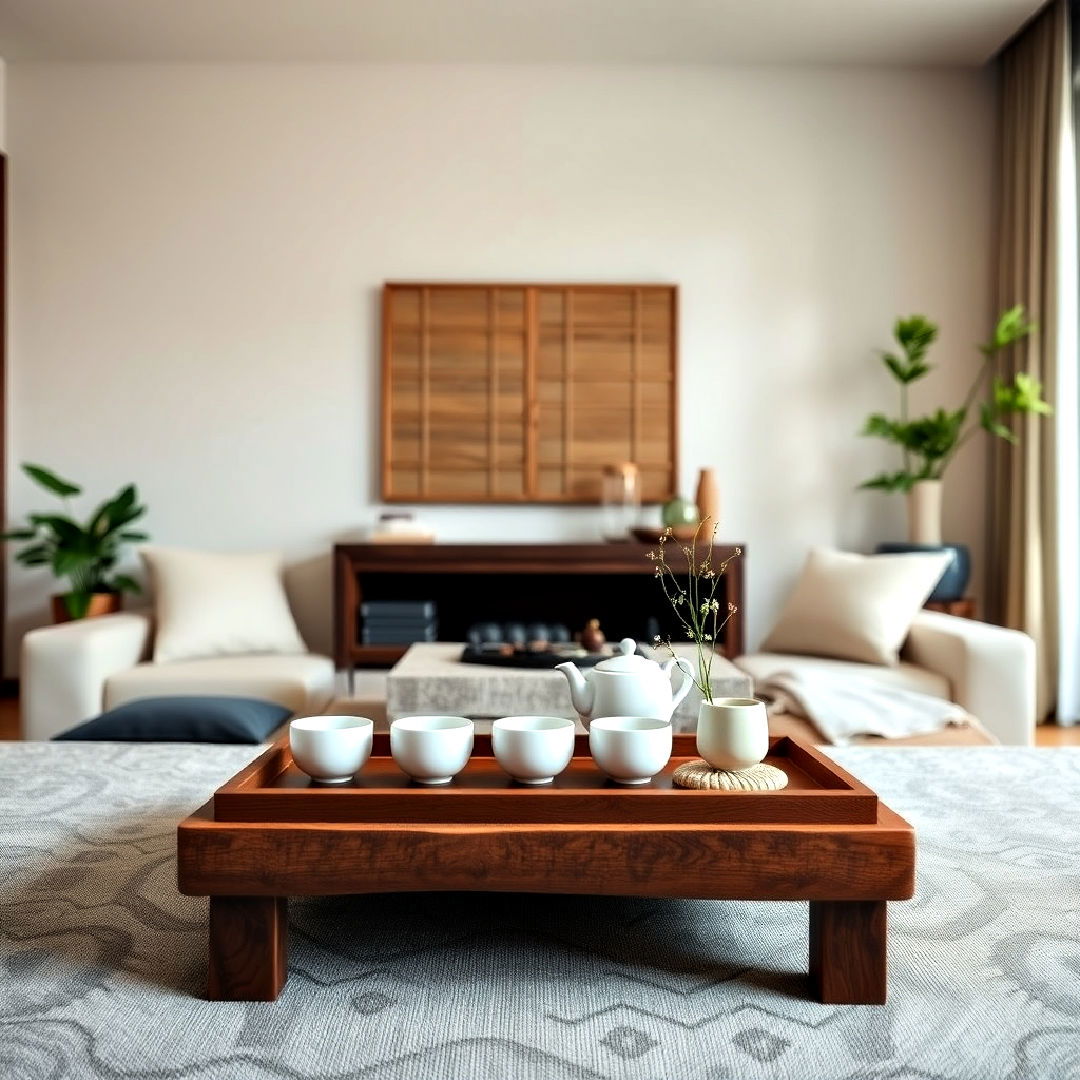
Create a small, Zen-inspired tea station in your living room to cultivate a moment of mindfulness. A simple wooden tray with a teapot, cups, and a few natural elements like bamboo or stone can create an intentional space for relaxation. The act of preparing and drinking tea becomes a calming ritual that adds to the peaceful atmosphere of the room. Keep the design minimal to focus on the experience.
19. Soft, Flowing Curtains
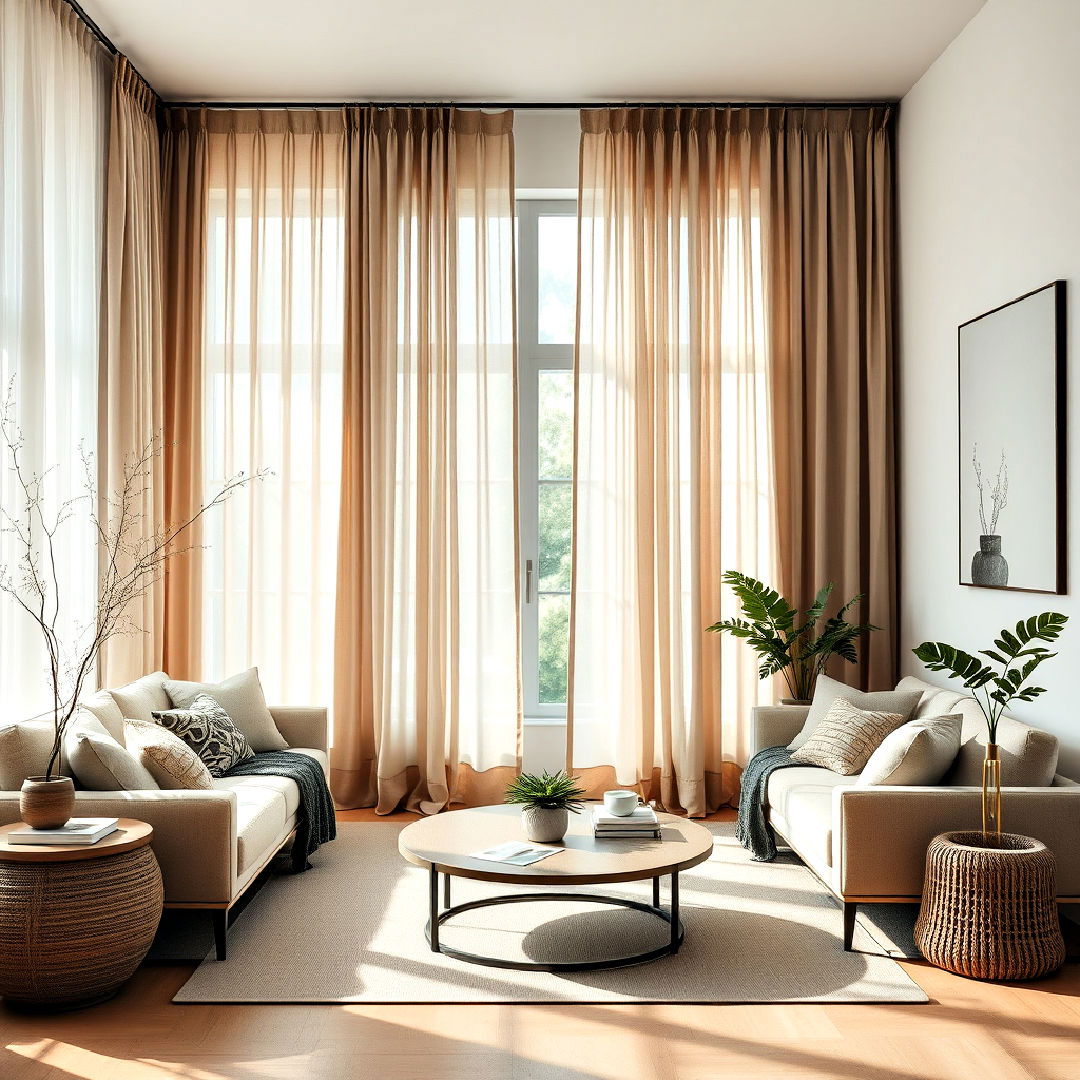
Discover beautifully designed zen living rooms that blend tranquility and style. Enhance the tranquil feel of your living room with soft, flowing curtains made from lightweight, natural fabrics. Sheer or linen curtains allow natural light to filter through while adding a gentle, breezy movement to the room. This subtle motion can evoke a sense of calm and serenity, mirroring the fluidity of Zen living. Choose neutral tones to maintain harmony with the rest of the décor.
20. Low Shelving and Open Storage
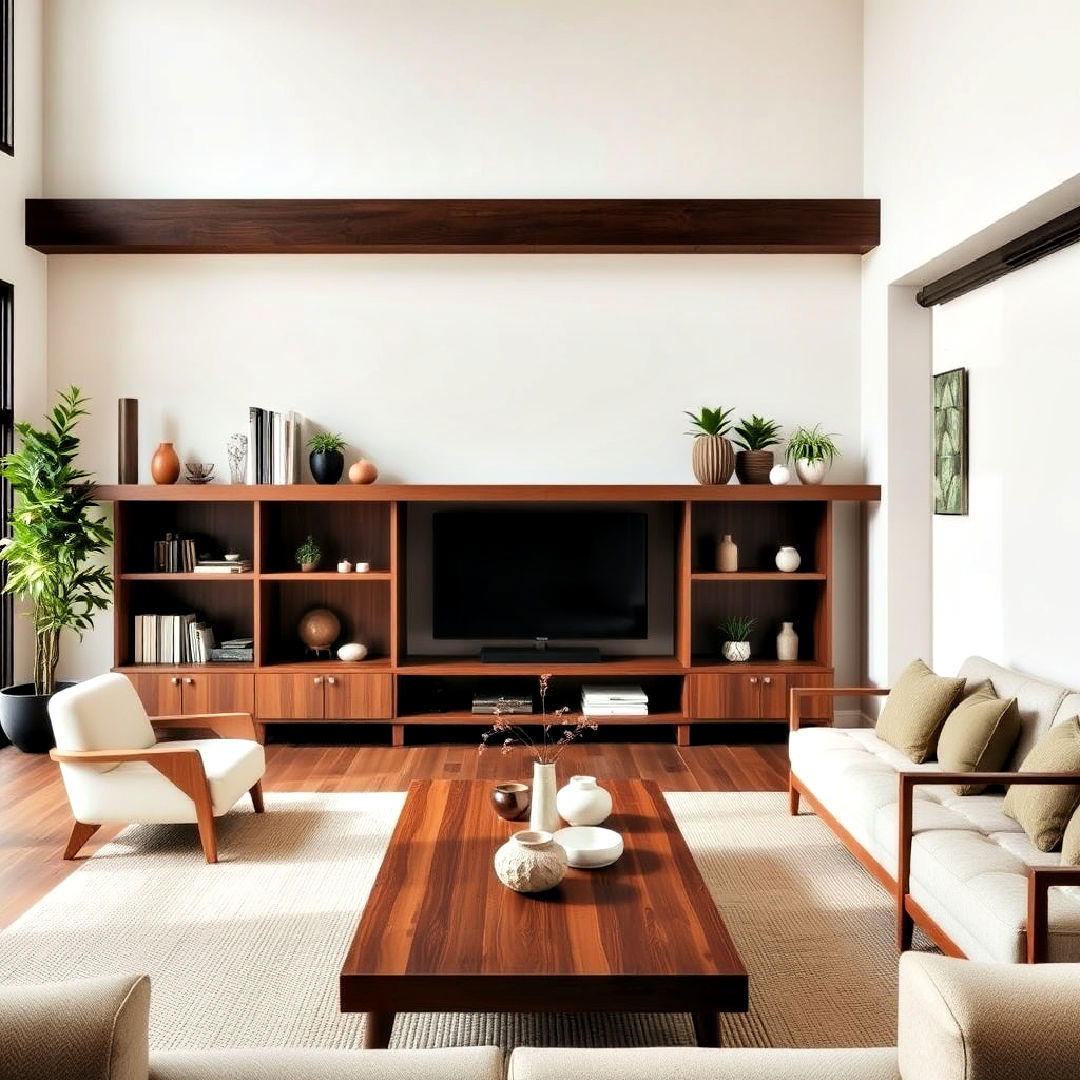
Low shelving units or open storage solutions help keep your living room functional without adding visual clutter. These storage options allow you to display a few select items, such as plants, books, or pottery, while keeping most things tucked away. Low shelving also preserves the openness of the space, encouraging a relaxed, free-flowing environment that is essential to Zen design.
21. Stones and Pebble Accents
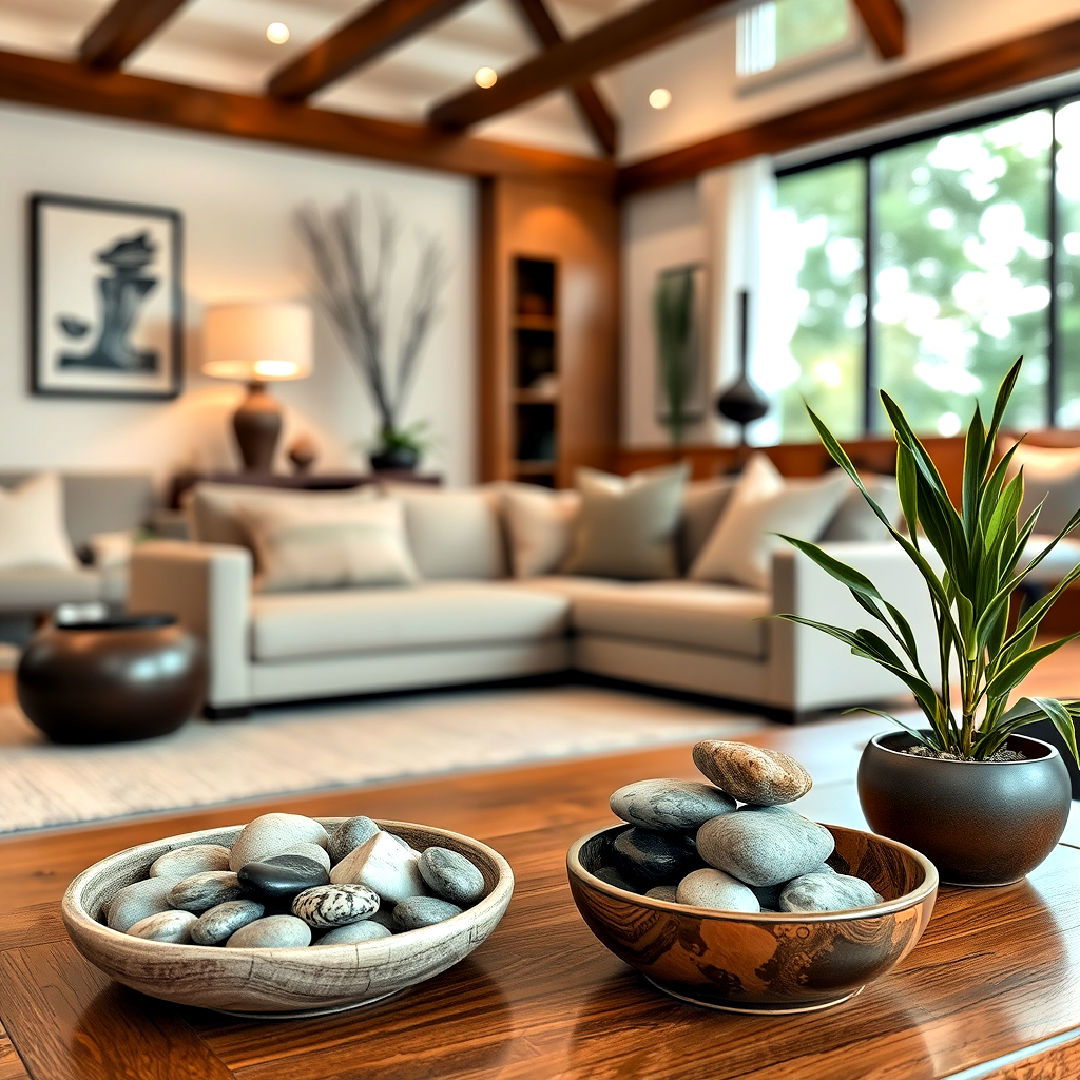
Bring natural elements into your living room by incorporating stones or pebbles as decorative accents. A small tray of river stones or a pebble arrangement in a planter can introduce a grounding texture without overwhelming the space. These natural materials evoke a sense of stillness and permanence, reinforcing the calm, balanced energy of the room. Keep the arrangement simple to avoid clutter.
22. Low Maintenance Greenery
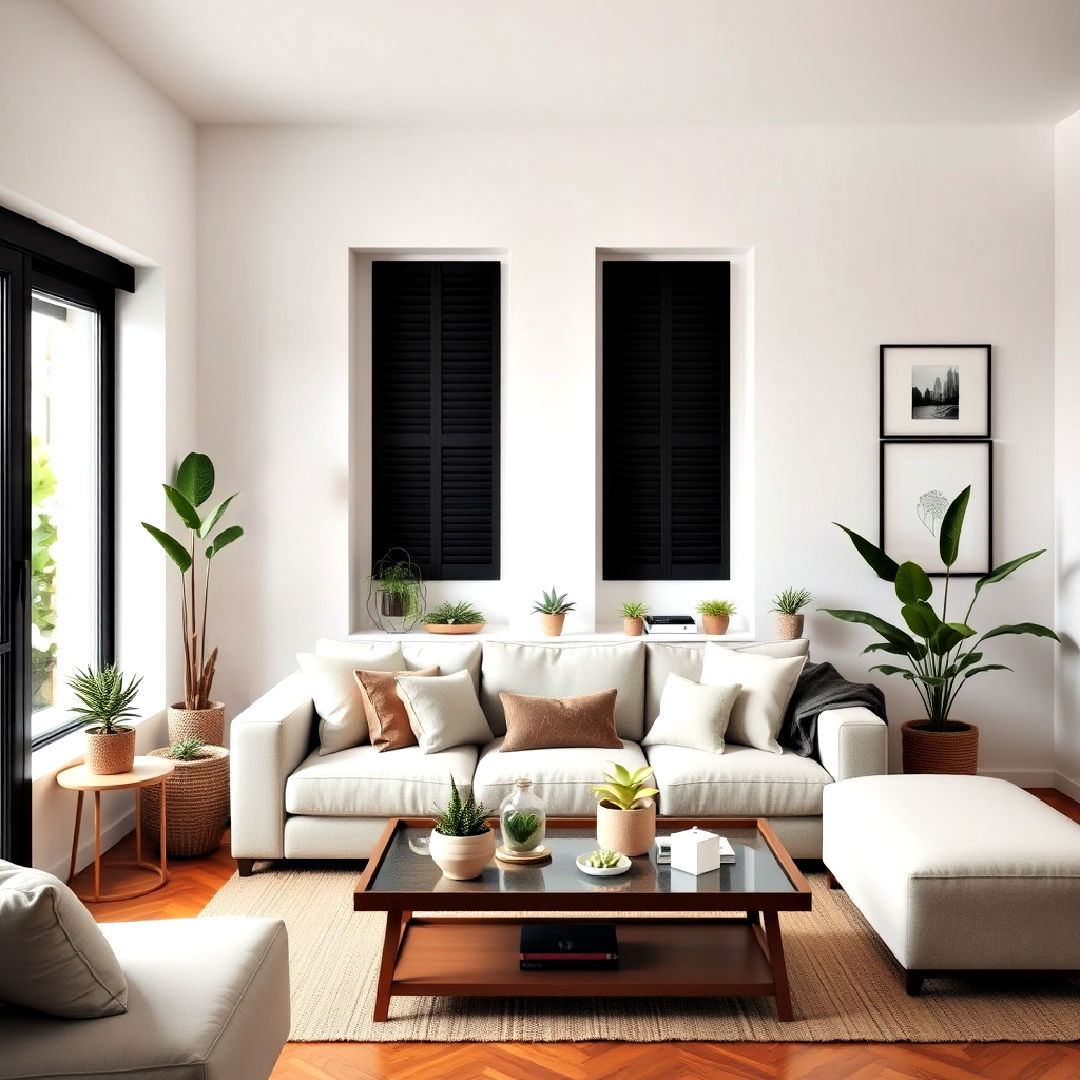
For a stress-free approach to adding greenery, choose low-maintenance plants like succulents or air plants. These plants require minimal care while still adding a natural, calming presence to your living room. Their simple forms and soft colors contribute to the Zen aesthetic without creating additional responsibilities. You can place them on shelves, tables, or window sills to complement the space.
23. Natural Stone or Wood Fireplace
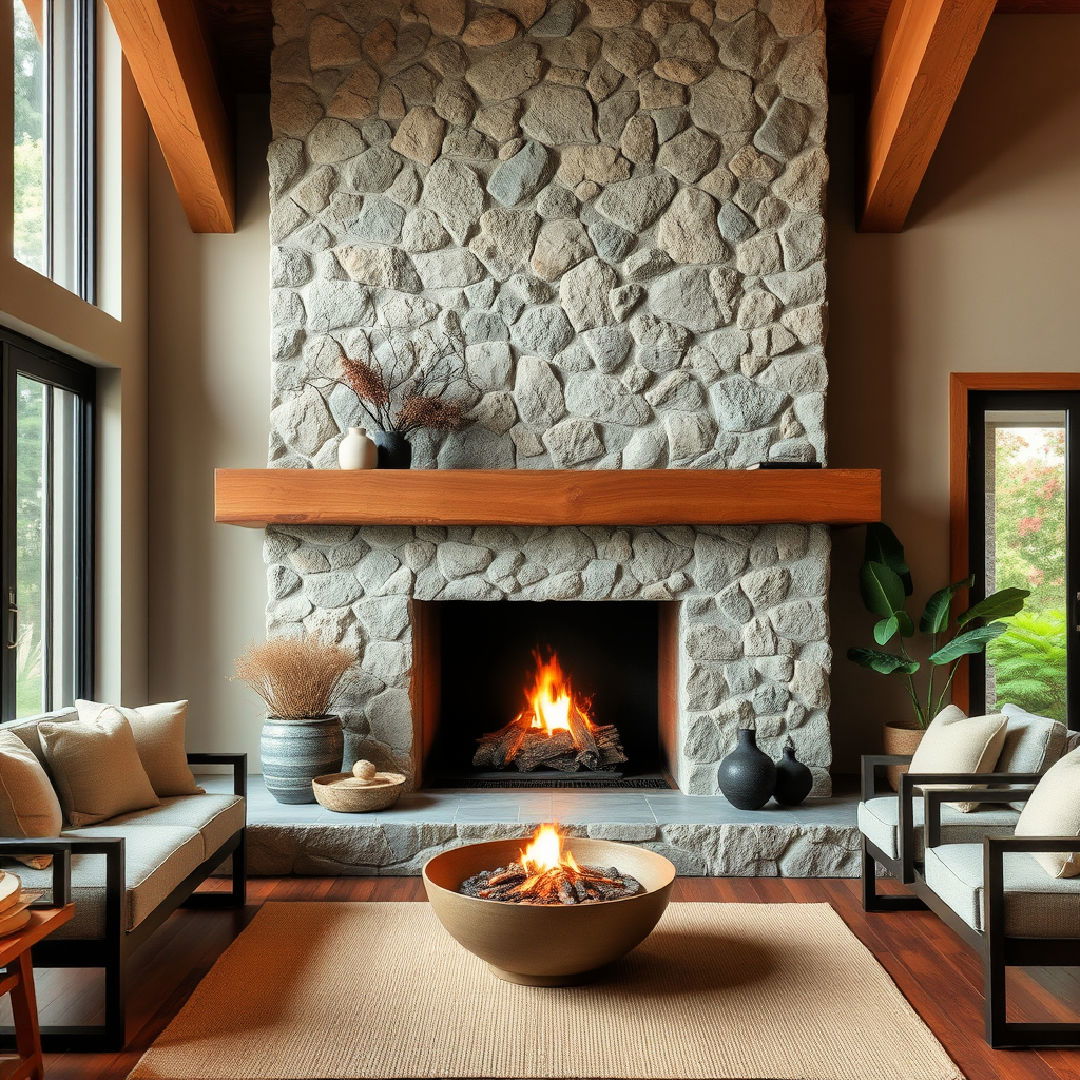
If you have a fireplace in your living room, consider using natural materials like stone or wood to frame it. A stone hearth or a wooden mantel creates a rustic, grounded feel that aligns with Zen design principles. The warmth and glow of a fire further enhance the tranquil atmosphere, offering a place to gather and reflect. Keep the fireplace décor minimal to allow the natural beauty of the materials to shine.
24. Wall Niches for Simple Displays
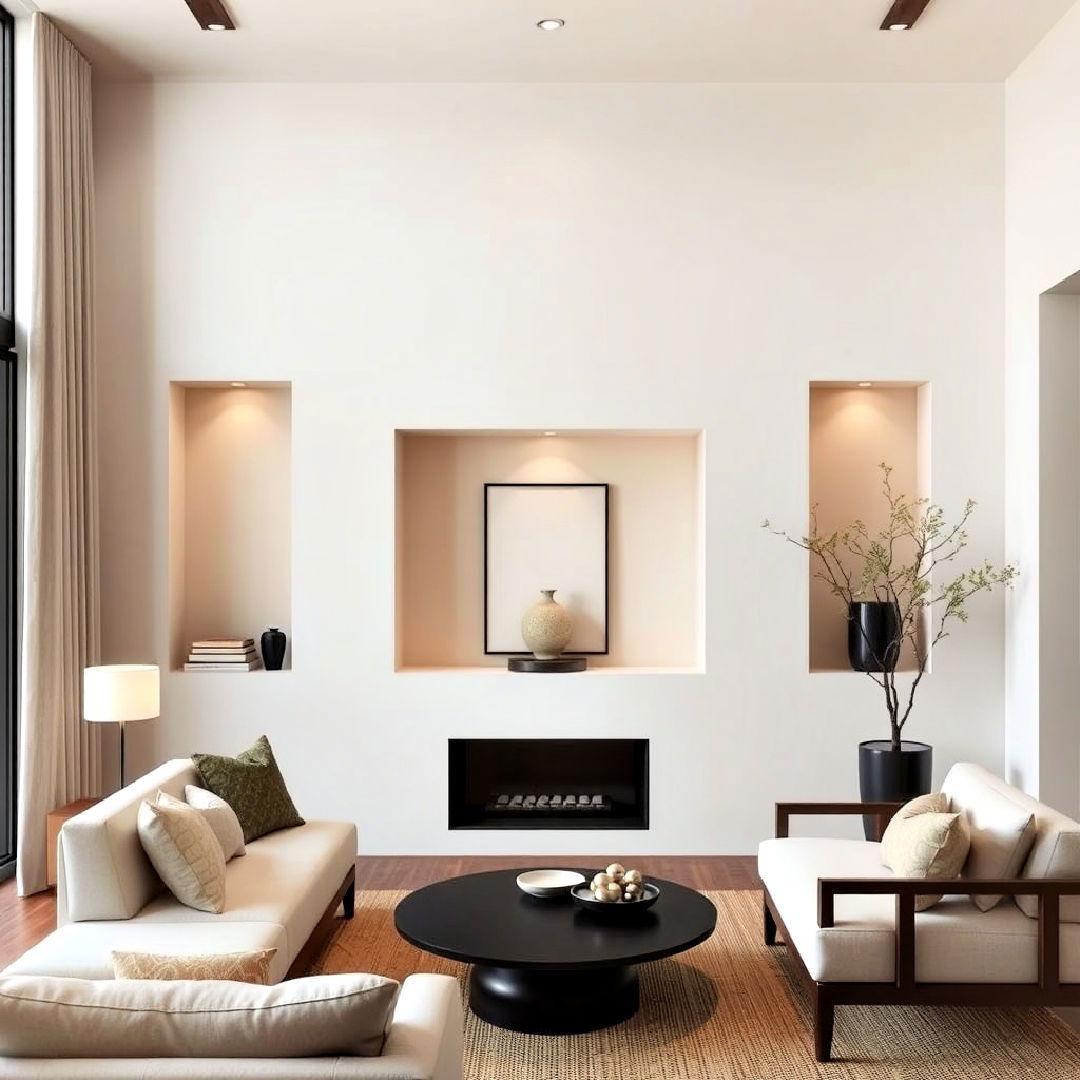
Incorporating wall niches into your living room allows for elegant, minimalist displays of art or objects. A single vase, candle, or piece of pottery in a niche can act as a focal point without cluttering the space. These small displays add personal touches while maintaining the room’s simplicity. The key is to keep the items in these niches minimal, promoting a sense of peace and order.
25. Simple Floor Lamps for Ambience
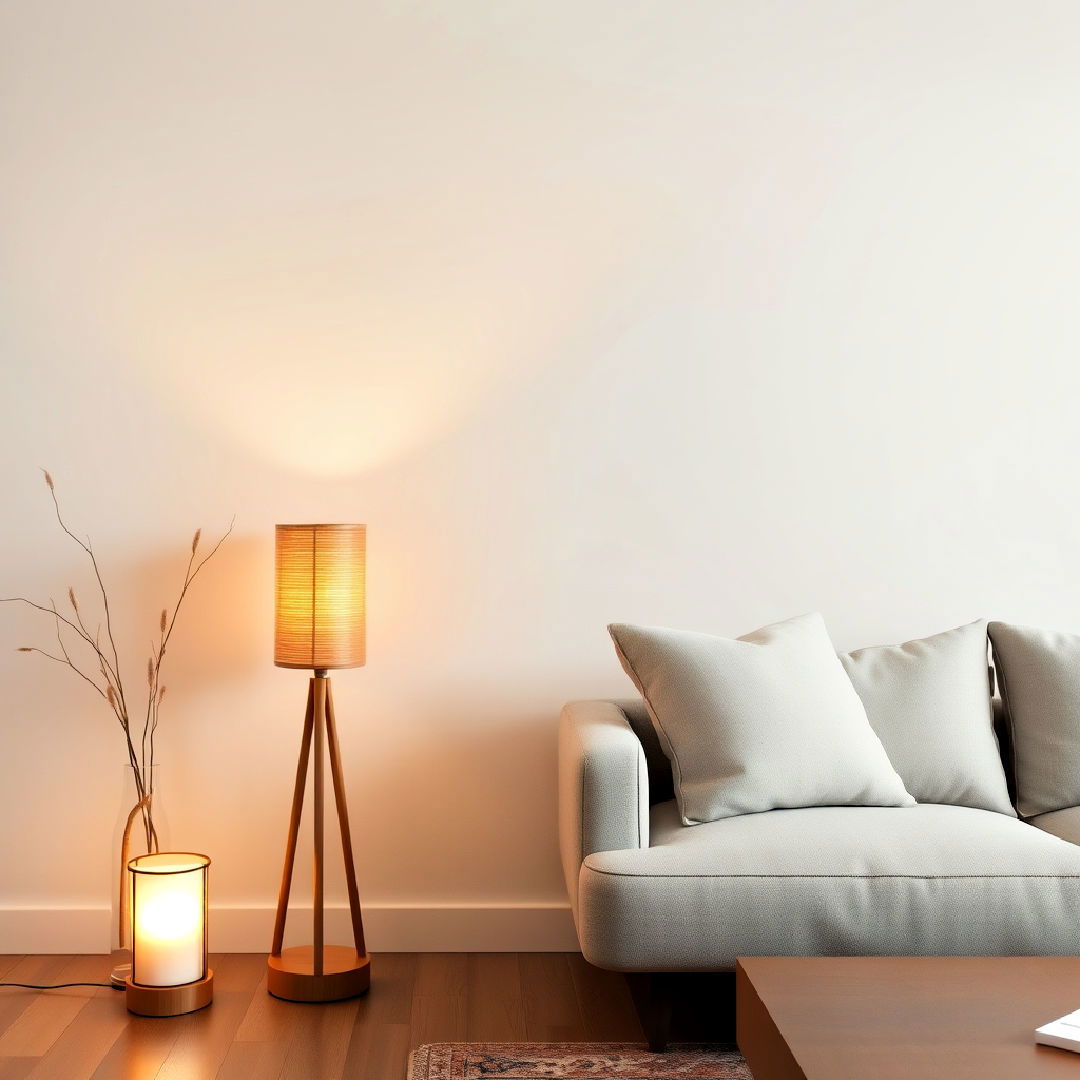
Opt for simple floor lamps with soft lighting to create a calming ambiance in the room. Lamps with natural materials like bamboo or wood, and soft, diffused light can enhance the overall Zen vibe. Place them in corners or next to seating areas to provide warmth and comfort without drawing too much attention. The gentle glow of these lamps adds to the peaceful, intimate atmosphere.
Conclusion:
Creating a Zen living room is about more than aesthetics; it’s a path to inner peace and harmony in your daily life. From minimalist furniture and neutral tones to calming greenery and purposeful accents, each element works together to foster tranquility. Embrace these ideas to design a space where mindfulness meets style, transforming your living room into a peaceful retreat that nurtures both body and mind.
Key Points:
- Minimalist Design: Opt for simple, functional furniture and a clutter-free open layout to create a sense of calm and spaciousness.
- Nature Integration: Incorporate natural light, indoor plants, and wooden accents to connect the space to the outdoors.
- Neutral and Soft Tones: Use a palette of neutral colors and soft textures to create a soothing, harmonious atmosphere.
- Purposeful Accents: Add meaningful elements like artwork, stones, or water features to enhance tranquility and focus.
- Comfort and Functionality: Choose low-profile lighting, floor seating, and multi-purpose furniture to prioritize comfort and practicality.
- Mindful Features: Include meditation corners, aromatherapy, and Zen-inspired areas like tea stations to encourage relaxation and mindfulness.
What to Do Next:
- Assess your living room’s current design and identify elements that clash with a Zen aesthetic (e.g., clutter or bold patterns).
- Start with small, impactful changes like decluttering, adding plants, or updating lighting.
- Gradually introduce natural materials, neutral tones, and purposeful accents.
- Create a dedicated space for mindfulness activities, such as meditation or quiet reflection.
- Explore multi-functional furniture and minimalist décor to maximize the space’s practicality and peacefulness.
- Maintain consistency by regularly refreshing the space, keeping it clutter-free and in tune with Zen principles.

